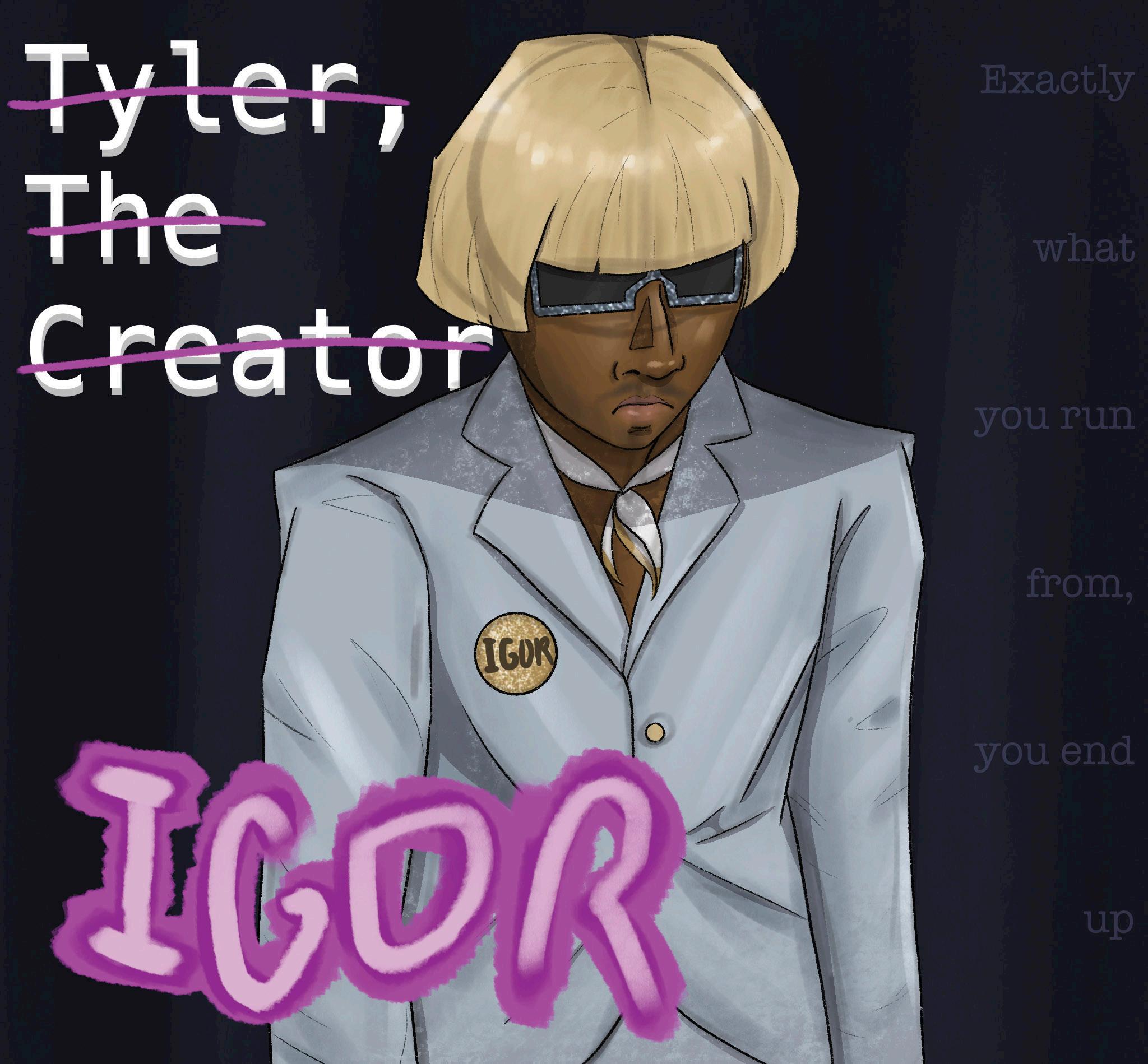




Vol.
thevarsity.ca

thevarsitynewspaper @TheVarsity
the.varsity the.varsity The Varsity
Sarah Artemia Kronenfeld editor@thevarsity.ca
Editor-in-Chief
Caroline Bellamy creative@thevarsity.ca
Creative Director
Andrea Zhao managingexternal@thevarsity.ca
Managing Editor, External
Shernise Mohammed-Ali managinginternal@thevarsity.ca
Managing Editor, Internal
Mekhi Quarshie online@thevarsity.ca
Managing Online Editor
Ajeetha Vithiyananthan copy@thevarsity.ca
Senior Copy Editor
Kyla Cassandra Cortez deputysce@thevarsity.ca
Deputy Senior Copy Editor
Jessie Schwalb news@thevarsity.ca
News Editor
Selia Sanchez deputynews@thevarsity.ca
Deputy News Editor
Maeve Ellis assistantnews@thevarsity.ca
Assistant News Editor
Eleanor Yuneun Park comment@thevarsity.ca
Comment Editor
Georgia Kelly biz@thevarsity.ca
Business & Labour Editor
Alice Boyle features@thevarsity.ca
Features Editor
Milena Pappalardo arts@thevarsity.ca
Arts & Culture Editor
Salma Ragheb science@thevarsity.ca
Science Editor
Kunal Dadlani sports@thevarsity.ca
Sports Editor
Arthur Dennyson Hamdani design@thevarsity.ca
Design Editor
Kaisa Kasekamp design@thevarsity.ca
Design Editor
Zeynep Poyanli photos@thevarsity.ca
Photo Editor
Jessica Lam illustration@thevarsity.ca
Illustration
Olya Fedossenko video@thevarsity.ca Video
Aaron Hong aaronh@thevarsity.ca
andrewh@thevarsity.ca
Kamilla
Cover Alexander Osodo :
Te Varsity would like to acknowledge that our ofce is built on the traditional territory of several First Nations, including the Huron-Wendat, the Petun First Nations, the Seneca, and most recently, the Mississaugas of the Credit. Journalists have historically harmed Indigenous communities by overlooking their stories, contributing to stereotypes, and telling their stories without their input. Terefore, we make this acknowledgement as a starting point for our responsibility to tell those stories more accurately, critically, and in accordance with the wishes of Indigenous Peoples.
 Alexander Osodo Varsity Contributor
Alexander Osodo Varsity Contributor
You must fnd a reason to fall in love with your art every time you approach your canvas. Devoid of this, the translation of thought to reality will reveal itself as an insurmountable wall. Must your work always have meaning to it beyond mere fascination? I personally don’t think so.
My afection for my art was reignited when it became a refection of my changing dialect with the world around me. I perceive it as an intimate relationship, one that is nurtured by wants and needs, susceptible to external pressures, but sharpened by a fervent dedication to reinterpreting your bride with the passage of time.
In the embryonic days of my voyage into the seas of creation, I adopted grandiose visions of what my art should be and do, visions that were desirable yet blinding. Ambitious strides toward veneration often met a festering frustration that gradually corroded my capacity to remain content with the present.
Overwhelmed and unfulflled, one day you may think, “Maybe I should give it all up.” Then you think, very quietly, “That path I crossed on my way from school would be a great spot to shoot at.” “The sky was just a bit more colourful today than it was yesterday.” “The alignment of trees
on this trail would make for a great composition.” “I wonder if person x would be down to shoot this weekend.” “Maybe I was overreacting.”
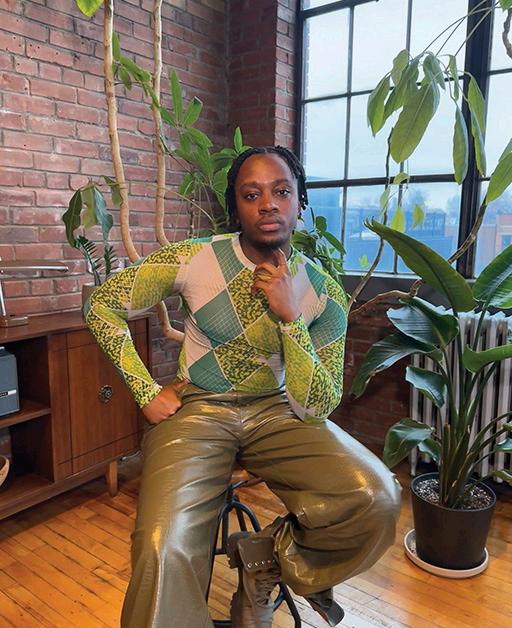
The present will begin to reveal to you that slowly but surely, your eye is becoming more keen. You are able to perceive detail better, colours and combinations more accurately, and your mind is able to more vividly compose
imaginary scenes that bring together assets strung across starkly diferent but surprisingly compatible outlets. All of a sudden, you can picture the vintage piece your friend once wore, complementing the aesthetic of that one graphic alleyway you often pass on your way to the mall.
In this process, you fnd yourself hungrier to experiment and bring ideas and people together. Following this, in a sense, your ambitions become a lot more momentary: I want to edit this photo, I want to create this design, I have this vision for how I can combine this and that. These short bursts of energy and inspiration become a lot more consistent, and much more centred on processes than outcomes. The world around you becomes a lot more romantic, and the atmosphere becomes one that naturally propels your mind towards worlds previously unimaginable scenes that you can’t wait to bring to through art.
As a Black creator, it is often easy to feel lost in the universe. More so, dedicating yourself to art and creation often comes at costs too high. I ask you to repeatedly fall in love again, and not tire of that sensation. Learn to interpret the fows of the world around you and to channel that into the evolution of your work. What goes too long unchanged often destroys itself.
In 2020, The Varsity launched our frst Black History Month (BHM) issue. Josie Kao and Ibnul Chowdhury, our editorial management team at the time, designed it based on conversations they’d had with multiple Black campus organizations — conversations about how The Varsity has historically fallen short in its coverage of Black students’ issues and how we could improve this coverage for the future.
The BHM issue has become a regular part of our yearly schedule — but looking at our process this year, we’ve realized it now involves a lot less collaboration. That’s something we want to change.
We’ve struggled to achieve our goals of establishing clearer communications and longterm relationships with Black student groups on campus. We’re hoping to change this going forward by continuing to make this outreach a priority. We’ll be reaching out to Black student groups long after February ends and make sure we’re setting out the time to meet on a non-transactional basis.
The BHM issue has never meant to be the be-all and end-all to improving our coverage, either, and it’s certainly not supposed to be the only time in the year when we try to spotlight Black stories at the university. Instead, it’s meant as an opportunity for us to set specifc goals to better our coverage and to create space that’s especially welcoming for Black writers. In the same vein, over the rest of the volume, we’ll continue making sure we’re covering Black stories at the university. We want Black students to be a regular aspect of our weekly coverage as writers and as interviewees.
Over the last few years, we’ve settled into a routine around how we create the BHM issue. Most of our eforts centre around welcoming new writers: that’s why we reach out to the whole student body about the issue and break down the process of writing for The Varsity That’s also why we try to build longer timelines into our internal production process so we have more time to communicate with writers.
On top of that, we compensate Black writers for writing articles, taking pictures, or illustrating for this issue, to help combat the long history of undervaluing Black labour. Although we can’t compensate writers all year, and our honoraria are not very large, we still want to make this gap less egregious wherever possible.
This process is far from infallible — we have considerable room to improve, both in our BHM issue in particular and our coverage of Black U of T communities as a whole. We need to do a lot more to improve our
communication with Black students and communities on campus. We also still lack Black editors in masthead positions at The Varsity Ideally, we don’t just want to introduce new Black writers to The Varsity in this BHM issue: we want to make sure we create a space that encourages them to return.
Ultimately, one of the ways we can start to address all of this is to talk openly about what we’re working to change. That’s why we’re writing this letter — as a start, and to make these commitments public. This shouldn’t be the last you hear from us — this is a very basic commitment, and serves to show how many more conversations we need to have about Black representation in The Varsity . But it’s a start. And if you do have thoughts you want to share, our inboxes are open.
We’re looking forward to those conversations.


“Journalism is often called the voice of the people, but how can it be the voice of the people when [those] reporting and creating stories are not an accurate representation of our world?”
Writer and lawyer Hadiya Roderique posed this question to the crowd gathered on Zoom for a virtual roundtable held by U of T’s Department of History on February 9. At the event, Black historians and journalists discussed the underrepresentation of Black people in Canadian journalism and the importance of reporting that touches on a variety of stories relevant to Black experiences and communities.
A 2022 survey conducted by the Canadian Association of Journalists found that approximately eight in 10 Canadian newsrooms had no Black or Indigenous journalists on staf. Acknowledging the underrepresentation of Black people in journalism, Roderique said, “In the absence of an inclusive environment and the absence of hearing [Black] stories, the quality of journalism sufers.”
Cheryl Thompson, a researcher and associate professor of performance at Toronto Metropolitan University, discussed the importance of making space for Black lineage and knowledge in current journalism. She spoke about how her grandmother’s advice to “listen” has infuenced
her writing to refect her community’s needs.
Thompson said that, due to their underrepresentation in mainstream newsrooms, “[many] young Black people are hesitant to get into journalism.” Responding to this worry, she stressed that, rather than focusing on the reception their journalism might get, it’s more important for young Black writers to make sure they know their history and then “go out and do the thing.”
Freelance journalist Neil Armstrong told the crowd how his career in journalism gave him the opportunity to be an activist. Armstrong explained that growing up, he wrote letters to The Gleaner — a daily newspaper published in Jamaica — that discussed various matters afecting his community. This experience showed him that he “had a voice that could be used to amplify the issues afecting [his] family and friends locally,” beginning his interest in journalism.
Throughout his more than 20-year journalism career, Armstrong has continued to use his platform to advocate for Black Canadians, maintaining that “Black media should be a voice for the voiceless.” Armstrong highlighted the intersection of historians and journalists, telling the crowd that newspapers give historians insight into societies of the past, and, in conjunction, journalists use history to aid their understanding of current events.
Roderique expresses that Black pain and tragedy are exploited in the media. “Our joy is
rare because I think the mainstream media would rather focus on Black pain,” she said.
Multiple authors have discussed how social media and companies commercialize violence against Black people, specifcally police violence, such as by aligning themselves with the Black Lives Matter movement without taking
meaningful action. In a 2023 US survey, 63 per cent of Black people said that news they see about Black people tends to be more negative than that about other ethnic or racialized groups.
“We need to be seen as full people; with the joy and the pain,” Roderique concluded.

The frst Canadian-born Black doctor. A speech that charted the way toward school desegregation. A luncheon celebrating Black history. This Black History Month, The Varsity is here to highlight signifcant events in the university’s history specifcally about U of T’s Black community.
The frst Canadian-born Black doctor
Founded in 1827, U of T’s doors were originally open to Black students. One notable early alumnus was Anderson Abbott, the frst Canadianborn Black doctor. In 1857, Dr. Abbott enrolled at University College — established at U of T in 1853 — to study chemistry. In 1858, he began his medical degree at the Toronto School of Medicine, which later became associated with U of T. After completing a supervised placement with Dr. Alexander Augusta — a family friend and Black community leader who lived in Toronto at the time and received his medical degree in 1860 — Dr. Abbott received his medical license in 1861.
Dr. Abbott ran successful medical practices — frst in Dundas, Ontario, and later in Toronto — and wrote for multiple publications on topics such as biology, desegregation, and politics. Each year, U of T now awards one Black undergraduate student the Dr. Anderson Abbott Award, which is worth $4,000 “on the basis of academic achievement, fnancial need and contribution to the black community.”
Setbacks
A few years later, U of T backtracked by implementing several segregationist laws that barred Black students from attending the school. Segregation was particularly prevalent in education, with Ontario and Nova Scotia setting up legally segregated schools in the late 1800s to keep Black students separate from other students. U of T also refused Black students admission under segregation policies — in one documented case, U of T initially accepted Lean Elizabeth Grifn, who applied to U of T medical school in 1923, but later denied her entry when the administration realized she was Black.
Leonard Braithwaite — a U of T alumnus
and the frst Black Canadian elected to a provincial legislature — played a signifcant role in challenging school segregation. In his frst speech to the Ontario Legislature on February 4, 1964, Braithwaite spoke out against the Separate Schools Act — a law that permitted racial segregation in Ontario K–12 schools — in a speech at Queen’s Park. He argued that the days of segregated schools had passed.
Braithwaite put forward a motion that the province remove the clause allowing segregated schools. One month later, education minister and future Ontario Premier Bill Davis introduced a bill that repealed the 114-year-old provision allowing for segregation. The last segregated school in Ontario closed within a year, in 1965.
Contemporary history
One of U of T’s specifc actions to tackle injustice is the creation of the Anti-Black Racism Task Force (ABRTF). The U of T administration announced the task force on September 23, 2020, as part of the university’s response to global protests against anti-Black racism.
In March 2021, the ABRTF delivered a fnal
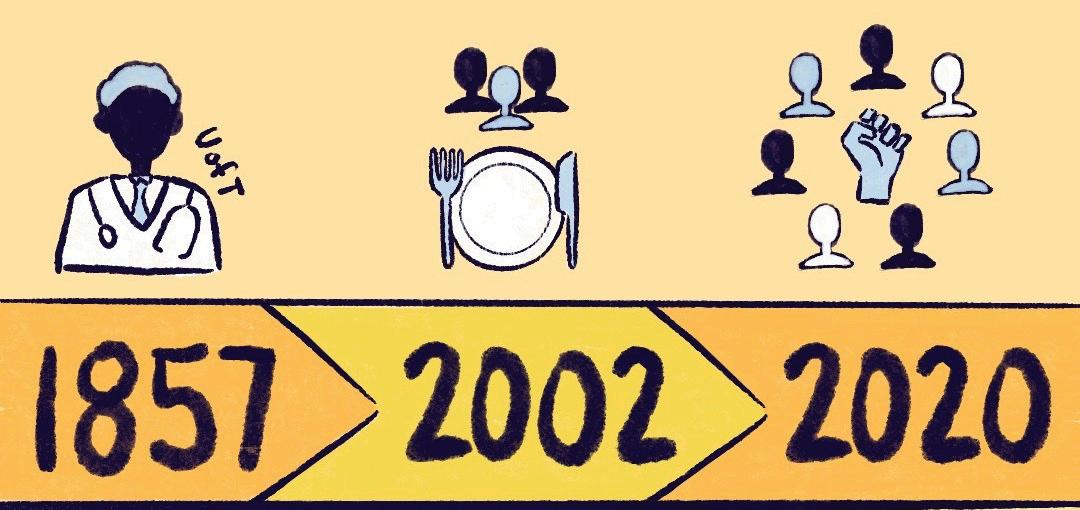

report outlining 56 action-oriented measures. These recommendations aim to tackle anti-Black racism and promote Black inclusion and excellence across the university’s three campuses.
Assistant professor in the Department of History and historian of modern Africa Safa Aidid mentioned in an email to The Varsity that she’s seen a cultural shift at U of T in how it approaches academia and community. Aidid spotlighted U of T’s hiring of more scholars who teach Black Canadian, Caribbean, and African American history. Aidid added that she feels “fortunate to be part of the new wave of young black scholars at U of T.” Aidid also mentioned a shift in student interest toward Black history. “Students are certainly more engaged and interested in Black history. Many of the students I teach are new to African history, but what brings them into my classroom is a deep interest in Africa and a sense that they aren’t getting nuanced perspectives from the media or pop culture,” she wrote.
As a whole, Aidid recognizes the steps taken by the university to promote greater degrees of Black representation and inclusion. “Though we still have a long way to go, it is encouraging to see these institutional commitments,” she wrote.
Refecting on history with the BHM luncheon
Another action taken by Black U of T community members that has left a mark on the university is the creation of the Black History Month Luncheon. The luncheon is an annual event that Glen Boothe and his colleagues in the university’s department of advancement — which coordinates U of T’s fundraising and outreach eforts — started in 2002. It features speakers and food and celebrates Black culture and excellence, intending to foster a sense of community and inclusiveness.
On the legacy of the luncheon, Boothe expresses a sentiment of contentment and fulfllment in all it has done to positively impact the Black community at U of T.
“The biggest satisfaction is the continued and growing support [for the luncheon]. Growth is always a good barometer of success, and each year there is a new group or individuals volunteering to be a part of [the luncheon] in a meaningful way,” wrote Boothe in an email to The Varsity
On a Friday afternoon, Muslim students at UTSC can often be seen lingering after Friday prayers — also known as Jummah — to talk to Imam Omar Patel.
Patel says U of T informed him on January 22 that it was removing him as the UTSC Imam, for allegedly making an anti-Israel and antisemitic post on Instagram. Still, when U of T invited him back to campus just two days later as a “member of the public,” Patel felt it was important to come and lead Friday prayers.
“If I don’t come for Jummah, and they bring in another Imam, the students then complain that ‘we miss our Imam,’ [or] ‘we want our Imam back,’ and I can’t say no to that,” said Patel in an interview with The Varsity
Patel became the Muslim chaplain at UTSC in 2016. As an Imam hired by the Muslim Chaplaincy at the University of Toronto — an independent non-proft organization focused on supporting and engaging Muslim youth — he catered to Muslim students by providing counselling sessions and weekly programs. He was directly employed by the Chaplaincy, not by U of T, but provided services on campus; a university spokesperson explained to The Varsity that the university makes “informal, unpaid, volunteer arrangements” with chaplaincies.
Patel denies having shared the post that U of T received complaints about in the weeks leading up to his removal. In an interview with The Varsity , Patel described the university’s decision to remove him from his role after approximately eight years as “shocking.”
Since Patel’s removal, students have advocated for his reinstatement, and over 6,300 people have currently signed a petition by the Muslim Chaplaincy to get him back.
“I think it’s so unfair, really, because [Imam Patel] was the only resource that we had on campus. And for [U of T] to take it away from us and then not be transparent as to why, they really showed the way that they see us as students,” Yasmin Said, a fourth-year student majoring in population health and double minoring in psychology and biology who had participated in Patel’s weekly program, told The Varsity “It really hurts."
The incident explained
According to an article by the CBC, Patel’s removal came after Hillel Ontario shared social media screenshots with U of T administrators on December 1, 2023, which it alleged that Patel had posted on his Instagram story.
Hillel Ontario is an organization that works to support Jewish students across nine diferent universities, including U of T, through campus programming and educational and religious initiatives.
The Instagram story in question — which Patel allegedly posted 45 days before Hillel Ontario sent it to U of T administrators — related to the ongoing confict between the Israeli government and Hamas. It featured a picture of a soldier holding an Israeli fag with a mirrored image of the soldier on the other side holding a Nazi fag. The caption in the story equated supporting Israel with supporting Nazi Germany and described Israel’s actions against Palestinians as genocide.
Multiple organizations that advocate against antisemitism have argued that comparing the Israeli government to the Nazi government is inherently antisemetic. A 2022 post by the World Jewish Congress — an international organization formed to advocate against antisemitism in the years leading up to the Holocaust — argues that comparing Israel or Zionists to Nazis diminishes the pain of millions who sufered during the Holocaust, playing into what it describes as “holocaust inversion.” “The Israeli–Palestinian confict is a territorial
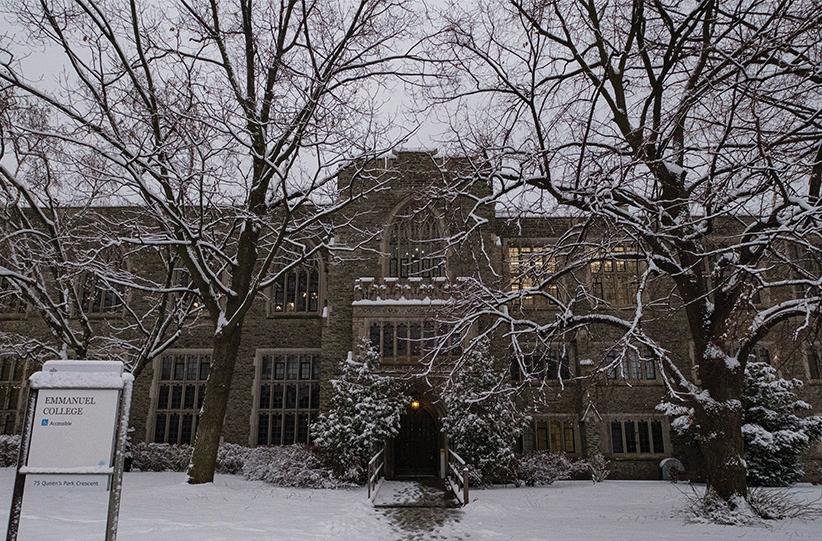
and political one, whereas the Holocaust was the attempt to systematically annihilate European Jewry,” the post reads.
Still, some recent commentators have drawn parallels between Israeli policies and policies undertaken by the Nazi regime. In a December 2023 essay in the New Yorker , Masha Gessen — a Russian-American and Jewish journalist who lost family members in the Holocaust — noted similarities between World War IIera ghettos and the “open-air prison” caused by Israel’s 16-year-long blockade of Gaza. They argued that treating the Holocaust as a singular event that can’t be compared to other events obscures potential lessons about our actions in the present.
Patel wrote that, at frst, when U of T sent him the screenshot of the story he allegedly shared, he found that the screenshot showed no Instagram username or profle picture. He brought this to administrators’ attention, but he says that U of T still told him to stop providing services because they needed to conduct an investigation into the post.
Five days later, the administrator sent Patel another screenshot of the same Instagram story, this time with his Instagram username and profle.
At the time the frst screenshot was sent, according to the CBC, Hillel Ontario posted an open letter about the screenshot and called on UTSC Principal Wisdom Tettey to hold Patel accountable. Hillel Ontario explained the story posted could entice violence against Jewish people. As of February 25, Hillel Ontario has taken down the open letter published on its website.
U of T’s Statement on Freedom of Speech states that no university members should use language or participate in any behaviour with the intent of “demean[ing] others” based on “group characteristics” such as ethnicity and ancestry. However, the policy notes that civility “may, on occasion, be superseded by the need to protect lawful freedom of speech.”
Patel claims that U of T was not transparent during its investigation of the incident and did not allow his employer, the Muslim Chaplaincy, to take part in it.
“I feel sad, I felt isolated. I felt that the institution that I cared for so deeply, providing services to staf, students, faculty, for a long time, didn’t have enough respect to be able to carry
an unbiased investigation or an investigation where they can share the details with myself or with my employer,” Patel said to The Varsity
He explained he tried many times to talk with U of T administrators to prove he had not posted the story on his Instagram; however, his pleas fell on “deaf ears.” “[U of T] failed me, they failed the Muslim students, and they failed the entire Muslim community. And it’s hurtful,” said Patel.
He alleged to the CBC that the second screenshot sent to U of T was altered in an attempt to “smear” him, as the frst screenshots had no ties to his profle or account.
When asked about Patel’s accusations, Hillel Ontario’s media relations stated to The Varsity that the organization asked U of T to investigate the issue after they received many reports of the “disturbing social media screenshots” from “_omarpatel,” Patel’s Instagram account. U of T, as of the time of publication, has not published any ofcial statement regarding the investigation or its decision to remove Patel.
Student reactions and advocacy
Zohal Akram — a third-year studying psychology and biology — has received spiritual and counselling services from Patel. She told The Varsity that Patel’s removal has left a huge gap for Muslim students who rely on him.
“He guided me toward getting the support I needed in difcult situations that I was in. And even now, to this day… he still checks up on students and still wants to know how you’re doing,” said Akram.
Usayd Ashraf, a frst-year student studying business and management, shared a similar sentiment. Having known Patel even before attending UTSC, he found that not having Patel as a chaplain makes him feel like he has lost vital resources. “His presence meant a lot to me. And I’m sure it meant a lot for others as well,” said Ashraf.
Both Ashraf and Akram expressed concerns about U of T’s investigation. “There was no proof of him committing whatever they accused him of committing,” Akram said.
Ashraf said he felt “scared” at the university’s lack of protections for Patel. “If [this] can happen to Imam Omar Patel then it can happen to any one of us [students],” he told The Varsity
On February 4, the Muslim Chaplaincy of Toronto started a petition calling on U of T to
apologize to Patel for the damage caused by accusations against him and to reinstate him as chaplain. In the petition, the Muslim Chaplaincy of Toronto states that the university’s investigation lacked “due process” or “transparency” and that the fnal letter sent to Patel on the investigation included no “evidence or reasoning for his termination.” The petition also brings up the lack of name on the screenshots frst sent by Hillel Ontario to U of T.
As of February 25, the petition has over 6,300 signatures.
Patel is worried about the lack of mental health support available at U of T that specifically caters to Muslim students and how this might cause students to lose faith in the university. He explained that, although U of T provides students with mental health supports, UTSC currently lacks a Muslim Chaplain available to students.
Although Chaplains serve primarily religious purposes, Patel has provided mental health support to Muslim students at UTSC. Since he was fred, Patel has had to stop providing counselling sessions and weekly gatherings. “We’re adding to the mental health crisis,” he said.
“I continue to come in to provide a level of support: a listening ear, a hand, a hug, if possible. Just any level of support to be present with students,” said Patel.
According to Scarborough Campus Students’ Union (SCSU) President Amrith David, the SCSU and the UTSC Muslim Student Association (MSA) are currently working on steps to “voice the concerns of students to administration.” Currently, their goal is to find a way to reinstate Patel and determine what happened during the university’s investigation. According to David, the SCSU and the MSA have had meetings with UTSC acting vice-president and principal Linda Johnston about this.
Johnston confirmed to The Varsity that the university undertook a fact-finding investigation in response to a complaint about a social media post but wrote that she could not provide more information for privacy reasons.
She emphasized that the spiritual support that chaplains provide is distinct from mental health counselling that the campus makes available and added that the university “[encourages] the Muslim Chaplaincy to make other chaplains available to our students as soon as possible.”
 Hannah Guo Varsity Contributor
Hannah Guo Varsity Contributor
In 1608, Mathieu Da Costa — an interpreter for Samuel de Champlain’s 1605 excursion — became the frst Black man to set foot on the landmass known today as Canada. James Douglas, the frst appointed Black politician in Canada, rose to the position of governor of British Columbia in 1851. In 1917, Black Canadian railway workers initiated the frst Black railway union in North America, later afliating with the American union Brotherhood of Sleeping Car Porters.
Despite the fact that Black people make up 4.3 per cent of Canada’s population as of the 2021 census, no K-12 curriculum in any province in Canada mandates teachers discuss Black history. U of T does not require students to take classes about history focused on Black people in Canada or worldwide. In interviews with The Varsity, however, professors and students discussed the importance of learning these histories, calling for the university to make a concerted efort to incorporate them into curricula and possibly require courses on Black history.
What courses and programs does U of T ofer on Black histories?
Bárbara Simões Daibert is a visiting professor in the Centre of Comparative Literatures who teaches CDN335 — Black Canadian Studies. In an email to The Varsity, she noted a lack of awareness of Black history within U of T. She highlighted how many Canadians don’t know that slavery existed in Canada, and the fact aroused surprise from students when she mentioned it during a lecture.
Daibert described teaching CDN335 as “exciting.” She noted that the course ofers her a chance to “show [her] students the diversity of their country
and the efects of African slavery in the Americas” and deconstruct “longstanding myths concerning identities.”
7.5 per cent of Torontonians identifed as Black, as of the 2021 Canadian census. However, The Varsity only found two courses ofered this year at UTSG that appear to focus specifcally on Black Canadian history: CDN335 and HIS265 — Black Canadian History. Only 13 students are currently enrolled in HIS265, and 20 are enrolled in CDN335. U of T ofers another course at the Scarborough campus — HISB22H3 F: Histories of Black Feminism Canada: From Runaway Slaves to #BlackLivesMatter — and none at UTM.
U of T also ofers the Certifcate in Black Canadian Studies, which students can earn by completing a group of courses across various programs that tackle topics from systematic discrimination to forms of resistance. According to Daibert, this certifcate is a “great and necessary step towards a more inclusive world.”
Currently, U of T’s African Studies Program — which includes a specialist, major, and minor — offers courses on socio-economic, cultural, environmental, and political transformations in Africa. The program aims to provide multidisciplinary perspectives on African histories, societies, and diasporas, and includes language studies.
Canada’s Black history
The experience at U of T refects broader Canadian trends. A 2023 study commissioned by the Canadian Commission for the United Nations Educational, Scientifc and Cultural Organization surveyed K–12 curricula across the country. It found a lack of curricula on Black Canadians, with many curricula only focusing on Black American history instead of highlighting the contributions of and specifc struggles faced by Black Canadians.
Some Ontarians have previously called for the
province to make Black history a K–12 education requirement, noting that the focus on American history shifts focus away from Canada’s historical and continued anti-Black racism.
Some other Canadian universities — including the University of Guelph and York University — ofer programs or certifcates in Black Canadian studies or Black Canadian History. However, other universities, such as the University of Ottawa, lack programs in Black Canadian studies or even courses on the topic.
In March 2021, the U of T Anti-Black Racism Task Force released its report, which included 56 recommendations that aimed to confront antiBlack racism and foster Black inclusion and excellence. The report included one recommendation related to Black pedagogy, or teaching methods designed to promote equity in educational settings: that the university “enhance the number of workshops and learning circles focused on anti-racist and inclusive pedagogies” and ofer workshops on anti-Black racism.
U of T accepted all 56 recommendations and tracks progress on these recommendations through its institutional commitment dashboard. The dashboard shows that the university has hired two people on term contracts to focus on anti-racist pedagogies, has developed a workshop series, and has hosted events. It has also curated resources such as the Anti-Black Racism Pedagogical Collection and is creating a repository to showcase Black leaders in science, technology, engineering, and math.
Incorporating and requiring Black histories
Ann Lopez, a professor at the Ontario Institute for Studies in Education and co-director of U of T’s Centre for Black Studies in Education, wrote in an email to The Varsity that U of T could both mandate specifc courses on Black histories and work
“Make an impact.”
This is the slogan adopted by De-Mario Knowles, a second-year UTSC student double majoring in neuroscience and mental health studies with a minor in French, who has become a prominent fgure across the UTSC community. A poet and keynote speaker for the mental health charity Step Above Stigma and hailing from Durham, Knowles worked with the university to create the Mental Health Minute — a series of short videos educating UTSC students on how to access mental health services.
The Varsity spoke with Knowles about his many passions and the importance of making an impact on his community.
The Varsity: How did you get involved in both poetry and keynote speaking?
De-Mario Knowles: It all started out by accident. I was accepted into this nonproft organization called Teen Perspective. We were an activism organization made by teens for teens. We wrote journal articles about diferent stuf going on in the world.
I wanted to do something that would make me stand out. When Bell Let’s Talk Day [which aims to destigmatize and raise awareness of mental health issues] was coming around, my president at the time was like, “Guys, we should put out a poem,” and she asked, “Who wants to volunteer?” And I raised my hand, because why not? And I instantly regretted the decision.
I wrote eight verses about how I felt about mental health and how it’s portrayed in the world. I literally titled it “I wrote this poem about mental health,” and posted it on my Instagram.
I started realizing how impactful being vulnerable in the public eye can be. I realized when I write stuf, I want it to be like a conversation. When I can write like that, I can allow other people to feel recognized about how they feel. Public speaking came as an add-on. I started getting invited to schools in my area to give speeches about my poem. So that’s the backstory. It’s not anything too fancy. I’m just a regular guy, 30 minutes away from Scarborough.
TV: You wrote a three-part poem project titled “From hurting to healing,” What was the process that went into creating that series?
D-MK: I originally started with happy poems that were encouraging. I’d be like, “Hey, it’s okay if you go through this; things will get better. You just have to stay optimistic.”
Sometimes, I just want to vent about how I feel and just be sad. I wanted the poem project to be exactly like my emotional timeline, where the frst one is super sad. Then, the middle one moves forward from what happened. The third one is what I learned from it and how I’m going to apply it to my future.
The frst poem that I wrote in the project, the one about grief, was actually written one year prior. I decided to make the other two as an expansion of it. I think [the poem about] grief took a while for me to put out because it’s my most personal poem.
It was about a very traumatic moment in my life. I was really scared, but I felt like this is something that can really impact the way that people feel. If I can put this out, I can start a dialogue about a very important topic that can resonate with many people.
I was lucky enough to win an award for it from an organization called Step Above Stigma. It’s
defnitely one of my favourite things that I put out in my poetry career.
TV: You began collaborating with UTSC’s Health & Wellness Centre to produce Mental Health Minutes, a series of brief videos aimed to raise awareness for department services. How important is mental health advocacy for you?
D-MK: Mental health advocacy is very important for me because I myself am someone who lives with mental health struggles on a day-today basis. I feel like there’s never too much advocacy for mental health.
to integrate Black pedagogy into existing courses. “Systemic and lasting change requires intentionality. Mandating specifc courses is the intentionality that is sometimes required to ensure that such knowledge that was often excluded is included,” she wrote.
Daibert echoed this idea. “We have to have specifc courses on this subject, on Black Canadian studies, simply because these studies are a very important part of what happened and still happens in this nation called Canada. On the other hand, it is necessary to include other non-white forms of knowledge, and this includes pedagogy, in our existing universities and curricula,” she wrote.
Some universities have implemented policies requiring students to take classes focused on Indigenous content before graduation. However, The Varsity could not fnd any examples of Canadian universities requiring courses focused on Black content.
“I would love to start by learning about Black culture,” Timothy Wang, a fourth-year mathematics student, said in an interview with The Varsity. As an international student at U of T with a Chinese background, Wang wrote that growing up, he and his friends rarely had the chance to meet people of other ethnicities. Coming to Canada for university, Wang felt that, although he had more chances to meet individuals from other backgrounds, he had little chance to learn about Black history in Canada.
“It is important for the contributions of Black Canadians to [Canada to] be embedded in courses beyond Black History Month,” wrote Lopez.
When asked for comment on its incorporation of Black history in course curricula, U of T told The Varsity that community members can refer to the Certifcate in Black Canadian Studies, the Anti-Black Racism Task Force dashboard, and the Scarborough Charter, which the university signed in 2021.
There’s always this stigma that paints a negative light on people who have mental illnesses. People with mental illnesses are just regular human beings. They shouldn’t have to deal with this negative label on their back 24/7. I feel like mental health advocacy helps to combat that.
TV: Your slogan has been to “make an impact,” What does making an impact mean for you?
D-MK: See, that’s a good question. I’m trying to fgure that out to this day. I think making an impact just means creating the change that you want to see in the world.
I like how ambiguous it is. I feel like it can apply to many diferent contexts. It can be for educational advocacy, journalism, science, or anything, as long as it makes a diference.
This interview has been edited for length and clarity.
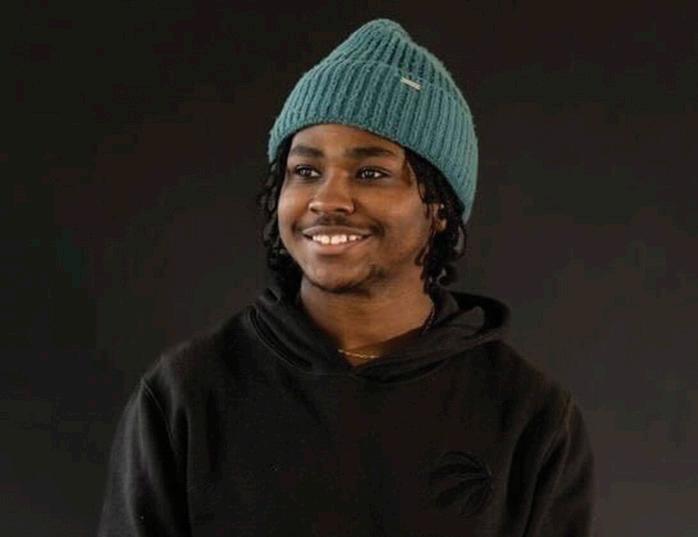


Vanessa Opoku — a fourth-year student double majoring in human biology and population health — is currently running under the ELEVATE UTSC slate.
She is the current Racialized Student Collective Coordinator with the SCSU. In this role, she organizes cultural events and operating hours for the Racialized Students’ Collective — an SCSU ofce that runs weekly events and aims to bridge the gap between the SCSU and student clubs that may not be aware of the union’s club funding.
“From what I've surveyed from students, there's a lot of skepticism with SCSU,” said Opoku in an interview with The Varsity. She believes there are a lot of “improvements” that the SCSU can make by forming closer connections with departments and the university as a whole, and she feels her experiences shape her to be a good candidate for the job.

Hunain Sindhu is running for SCSU president under the IMPACT UTSC slate. As a ffth-year environmental geosciences specialist, he has been interested in campaigning for an SCSU executive position “for a while,” he said in an interview with The Varsity. He served as president of the Muslim Students’ Association over the last two years and is the current SCSU director of physical and environmental sciences.
“The president is responsible for shaping not only the vision, but also sort of the mindset of the team and leading the executive team of SCSU… I have a lot in mind that I want to change, or implement, or make better,” said Sindhu in an interview with The Varsity

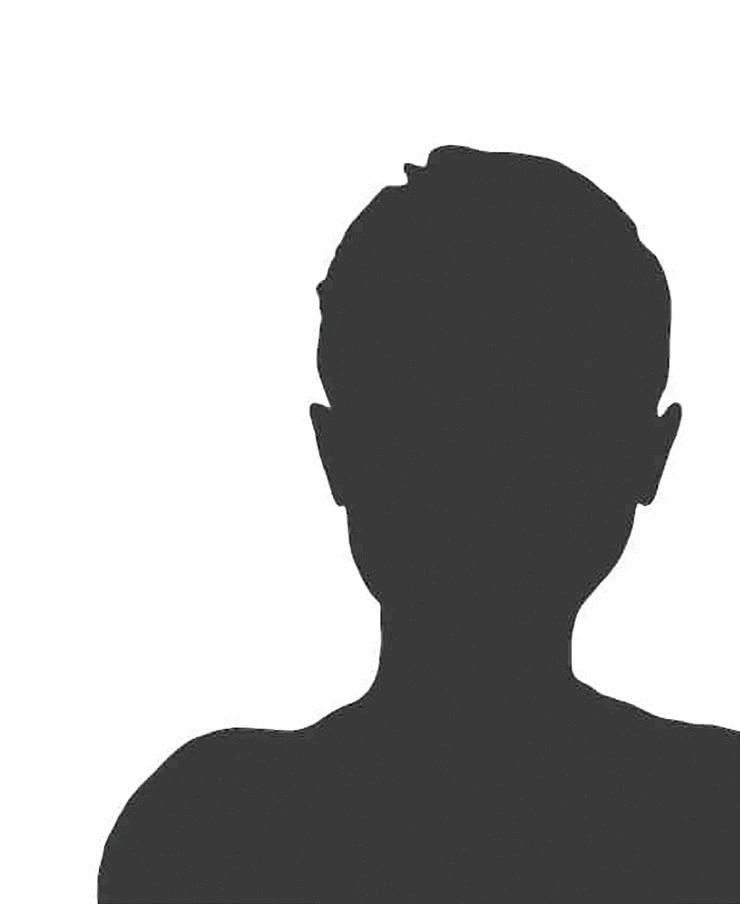
Her main campaign points include creating a community care hub with mental health support, providing resources to students through discounts to platforms like Grammarly, and championing a Bias Reporting System and Anti-Racism Task Force to ensure a safe and inclusive environment for all.
“I want to advocate for you correctly,” she said.
Desteenie Africa is running on the ELEVATE UTSC slate. A ffth-year city studies major with a double minor in English and sociology, Africa told The Varsity that her familiarity with current academic policies and her wish to “make students more prideful that they are specifcally at UTSC and not just U of T as a whole” motivated her to run for this position.
The primary focus of Africa’s advocacy, if elected, will be extending the credit/no credit period to allow UTSC students to choose no credit after receiving their exam grades.
Africa also hopes to advocate for a policy where courses with over 100 students enrolled must ofer a web or hybrid option.
Finally, Africa wants to introduce a course recovery policy that would let students remove a failing grade from their transcript if they retook and passed the course. Such a policy exists at UTM, but not at UTSC or UTSG.
Africa has worked with AccessAbility Services — a thea student and academic service equity ofce at UTSC that coordinates student accommodations — since her frst year. She said this job has helped her identify existing communication barriers between administration, professors, and students, which helped spark her interest in the VP AUA position.
“I’m like the voice for everyone,” Gori Debo-Adesina, a fourth-year political science and philosophy double major, told The Varsity when describing why he wanted to run for VP external.
Currently representing philosophy students on the SCSU’s Board of Directors, he said that his experience advocating for students and forming relationships with his high school administration prepared him for the role. Debo-Adesina’s campaign focuses on addressing students’ needs by revamping health, housing, and transit.
To ensure students can access quality health insurance after graduation, he wants to work with GreenShield — the SCSU’s current health insurance provider — to create a system where students can retain the same healthcare plan after graduation, where the union would pass insurance on to individual graduates.
“We know how important residency is for people and, even within the opening of Harmony Commons, people are still struggling to fnd a good residence,” he said. To address this issue, he hopes to create a platform where students can fnd affordable housing options with landlords vetted by the SCSU.
Debo-Adesina also hopes to continue the SCSU’s advocacy for a bus connecting the UTSG and UTSC campuses and a universal pass similar to that provided by the UTMSU.


His main campaign points include overseeing an expansion of the Student Centre to create an inviting, equitable space for campus groups; designing policies so that UTSC provides students from globally distressed regions with fnancial, academic, and mental health accommodations; and establishing avenues of communication so students can share their aspirations and concerns about the SCSU’s initiatives and operations.
“Really getting those ideas from students that a lot of students may have is important,” he said.
Zanira Manesiya — a ffth-year student double majoring in neuroscience and mental health studies and minoring in English literature — is running as part of the IMPACT UTSC slate. Currently, she sits on the UTSC Campus Afairs Committee and the Council on Student Services, which advises UTSC on student life. She also works as a coordinator for the SCSU’s Food Centre.
In an interview with The Varsity, Manesiya outlined three main focuses if elected.
First, she plans to advocate for increased departmental scholarships or grants to further support students fnancially. She also hopes to advocate for afordable textbooks and other course materials for students.
Second, she plans to lobby for “academic policies that will ease the academic burden on students,” such as pushing the deadline for a student to designate a course credit/no credit until after students receive their course grades.
Finally, she hopes to introduce an Academic Advocacy Coordinator role at the SCSU to help students deal with academic integrity ofences and support the work of the VP AUA.
“Working with people of all backgrounds, both locally and globally, has championed my belief that supporting each other and working together is the best way to move forward,” she told The Varsity
Omar Mousa, a fourth-year linguistics major specializing in psycholinguistics, is running for VP external on the Impact UTSC slate.
In an interview with The Varsity, Mousa described himself as a person “who likes to take the lead.” He said that, through direct work with the UTSC administration and holding the administration accountable for their actions, he could make an actual diference as a VP external.
Mousa’s campaign focuses on decreasing the fnancial burden for students. He wants to implement a free or discounted transit pass for UTSC students and collaborate with the administration to reconsider campus housing fees.
He also said that one of his objectives is to organize rallies that would hold the administration responsible for recognizing global events that afect students. He previously organized walkouts for the Palestinian Culture Club and continues to work with the Toronto Chapter of the Palestinian Youth Movement.
Finally, Mousa wants to strengthen tri-campus solidarity through grassroots organizing on topics such as the Boycott, Divest, Sanction movement — a movement that aims to exert fnancial pressure on the Israeli government.


Rafay Malik — a third-year student specializing in political science — is the only candidate running to be the 2024–2025 Scarborough Campus Students’ Union (SCSU) vice-president, campus life. A part of the IMPACT UTSC slate,
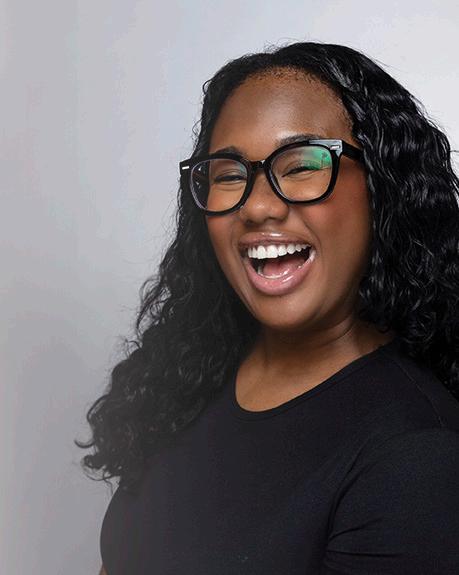
Arthur
Aanya Sinha, a fourth-year international student double majoring in psychology and religious literature, is running as part of the ELEVATE UTSC slate.
Currently, Sinha is a part of the Mental Health Advisory Board led by Neel Joshi, Dean of Student Experience & Wellbeing. She believes her experience in mental health advocacy and awareness makes her well-suited for the role.
“I care about people and I care about how UTSC is forming… I am very proud to say I’m from UTSC and I want to make sure that that legacy goes on,” she told The Varsity Her platform focuses on organizing events for cultural understanding and enhancing mental health on campus. Sinha, who identifes as LGBTQ+, wants to highlight related events and initiate more collaboration with cultural clubs. She also wants to support facilities, improve safe spaces funding, increase scholarships, and promote equity by ensuring accessibility resources.
Sinha says she is devoted to making sure union members support students by promoting transparency. “I think the biggest problem a lot of students go through is not knowing about community and not having friends that are going through the same thing as them.”
Malik has been involved in a number of clubs at UTSC, including the Pakistani Students’ Association and the Muslim Students’ Association. Malik has also served as an emcee for the SCSU’s Frosh.
In an interview with The Varsity, Malik emphasized a few of his campaign focuses.
First, he plans to organize a start-up fund for clubs to streamline the process of creating a club on campus. He hopes that students who submit a request to start a club can be immediately accepted, receiving money from the fund to cover their start-up costs.
Second, Malik hopes to improve collaboration between the SCSU and the Ofce of Student Experience & Wellbeing (OSCW), which oversees multiple departments, including AccessAbility Services; the Academic Advising & Career Centre; the International Student Centre; and Student Housing and Residence Life. In particular, he wants to improve transparency and communication between the two organizations and introduce regular meetings between staf members to plan events ahead of time.
Finally, he’s planning to “bring back the Toronto Raptors subsidized sports games” and organize a beginning-of-the-year concert that would be free for students to attend.
If elected, Malik hopes to see the new SCSU executive team be “much more involved and incorporated into the actual student body” so students can recognize and approach them.
didate running for 2024–2025 Scarborough Campus Students’ Union (SCSU) vice-president (VP) operations as part of the IMPACT UTSC slate. Bah has been an executive for U of T’s Black Students in Business club for fve years. She is also involved in the UTSC Geography and City Studies Student Association. In an interview with The Varsity, Bah said that her extracurricular activities “taught [her] a lot about leadership and budgeting.” She’s also familiar with the union’s operations, having worked at the SCSU front desk.
Bah’s campaign aims to support students in managing their fnances amid infation. Her three priorities centre around improving the SCSU’s Food Centre, the union’s student tax clinics, and Bistro 1265’s menu. Through fnancial workshops she wants to “help students better manage their money” given recent infation.
Additionally, Bah hopes to create a “studentto-renovation committee” that would direct a renovation of the student centre, ensuring that students’ voices are heard and implemented.
Concerning transparency, Bah is committed to overseeing expenses and ensuring “that these [transactions] refect what students are really wanting on campus.” Lastly, she hopes to encourage students to take advantage of what SCSU has to ofer and “[know] where their money is going.”

Kamilla Bekbossynova
Shifara hopes to establish a Community Care Center as a part of the Student Center expansion to prioritize proactive outreach to address student well-being. She also plans to implement an online tool where students can share their experiences related to discrimination anonymously as a way to “pinpoint recurrences” of particular issues. Finally, she hopes to partner with LGBTQ+ organizations to introduce new bursaries, programming, and safe spaces.
“I’m running for this role because I’m passionate about providing that inclusive environment for all UTSC students and uplifting the diverse and underrepresented communities here on campus,” Shifara told The Varsity. “I want everyone to be seen and heard. And I’m here to listen and take responsibility to act on students’ concerns.”
Shifara said that she aims to work with the president to propose policies that provide fnancial, academic, and emotional support to those from distressed regions. She also plans to engage with a wide range of campus groups to run events specifc to certain marginalized groups.
Shifara’s experience includes helping with Frosh, teaching youth at her community centre, and participating in Black Student Engagement — a program through UTSC’s Ofce of Student Experience & Wellbeing that provides spaces for Black students to access support services.
How to vote: UTSC undergraduate students can cast their votes from March 4–6, 10:00 am to 6:00 pm, in the Instructional Centre, Student Centre, and Bladen Wing hallway. Along with voting for candidates, students can vote to approve or not approve a $7.23 per session per full time student and $3.62 per session per part time student levy paid to Regenesis UTSC, an environmentalism club.
What does each role do?
The President acts as chief spokesperson for the organization, leads the other executives, and helps determine the union’s direction.
The Vice-president (VP) academic and university afairs represents the union in various university committees, lobbies U of T to improve students’ experiences, and provides advice to students on academic afairs.
The VP external develops the union’s political campaigns and represents the union externally and in some university committees.
The VP operations creates the union’s budget, administers payroll, negotiates with staf, and keeps documents up to date, among other responsibilities.
The VP campus life is responsible for recommending, scheduling, advertising, and coordinating all of the SCSU’s events, along with processing clubs’ requests for funding and representing the union on university committees related to residence, food, and licensing.
The VP equity raises awareness of discrimination at UTSC and in the community, ensures that the union’s actions refect the union’s anti-oppression stances, and acts as the ofcial liaison with U of T organizations that handle topics surrounding discrimination.
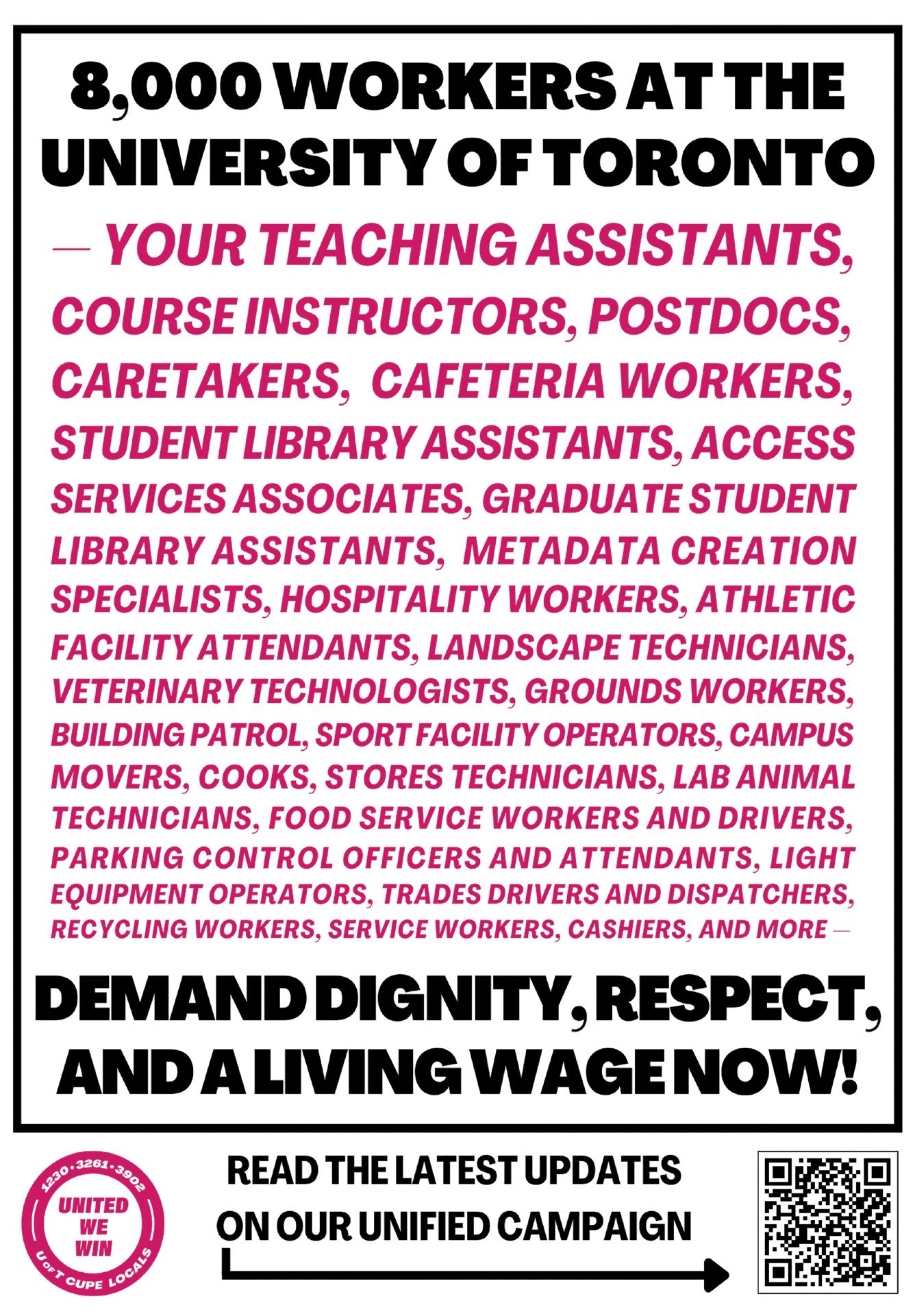
Beauty is wild.
Wild in the depth of its meaning.
Wild in the interesting ways it can be expressed. Wildly beautiful in the diverse ways it can be interpreted and understood by its audience.
Chizuloke Olisaekee, in her 12 years on earth, exemplifed beauty in many wild ways.
She exemplifed beauty through her love for dance, her art, and her stage performances — Miracle being her biggest and most special performance. She elegantly served many roles during this school musical. As a bookseller, she proudly displayed beauty as she walked across the stage showcasing her own storybook, Shy Sharon. As a ribbon dancer, her beauty radiated as she majestically swung the red ribbon, tall and proud, in many directions.
Chizuloke symbolized beauty as she distributed and read Shy Sharon to older and younger school children in her home country, Nigeria. She embodied beauty as she lived out her fctional story Shy Sharon, when she helped a withdrawn classmate slowly bud out of her shell to make a presentation in class — a classmate who then also began to advocate for her needs to the teacher.
Chizuloke boldly demonstrated beauty in dance, regardless of who was or wasn’t watching. A proud lover of Afrobeat, K-pop, and gospel, she danced to the music of her favourite artists playing in her head as she walked the streets of Toronto, rode the bus, spent time with friends, and even when she lay with her back to the foor as she fxed a broken chair. She magically wooed the audience during her last school talent show when she snuck surprisingly onto the stage, injecting new dance steps into the routine, electrifying the room with a resultant roar.
She displayed beauty as the youngest person in the classic choir in church.
Chizuloke symbolized beauty by embracing her identity, wearing her natural hair — Black and proud — and standing up for her culture and food. For her, food was more than just sustenance. It was an expression of identity, a connection to others which she passionately expressed through her desire to help people understand Nigerian food and culture. Chizuloke proudly cherished her name and its meaning — God is sufcient — in several beautiful ways. She made sure she taught others how to pronounce it correctly and carefully decorated it with fowers and/or love symbols whenever she wrote it.
Through her love for nature — puppies, fowers, and preserving the earth — Chizuloke radiated beauty by prioritizing reuse. In her own small ways, she redesigned used boxes, wrapping papers, and containers that would otherwise have been thrown away.
By seamlessly connecting with people around her, irrespective of age, nationality, and identity, and making sure everyone felt included, Chizuloke expressed beauty. Her love for God, her family, friends, and community, which she willingly gave back to, is a great example of beauty, which we hope to carry on.
Give Chizuloke a piece of paper, pen, pencil, or Sharpie and wait to see the dimension of beauty she will produce. It is no surprise her class teacher always looked forward to her assignments, especially her writing and art projects, as they were laced with passion and creativity! Her beautiful creativity went beyond writing materials; she also expressed it in the unique ways she designed food. She had big dreams of baking unique Afrocentric-designed cakes when she got older.
Though her physical candlelight was tragically blown out, her beauty lives on in its purest and wildest form. The light her beauty lit in the hearts of many shines brighter. She lives on in our hearts and is fondly celebrated in The Varsity’s BHM issue and always.
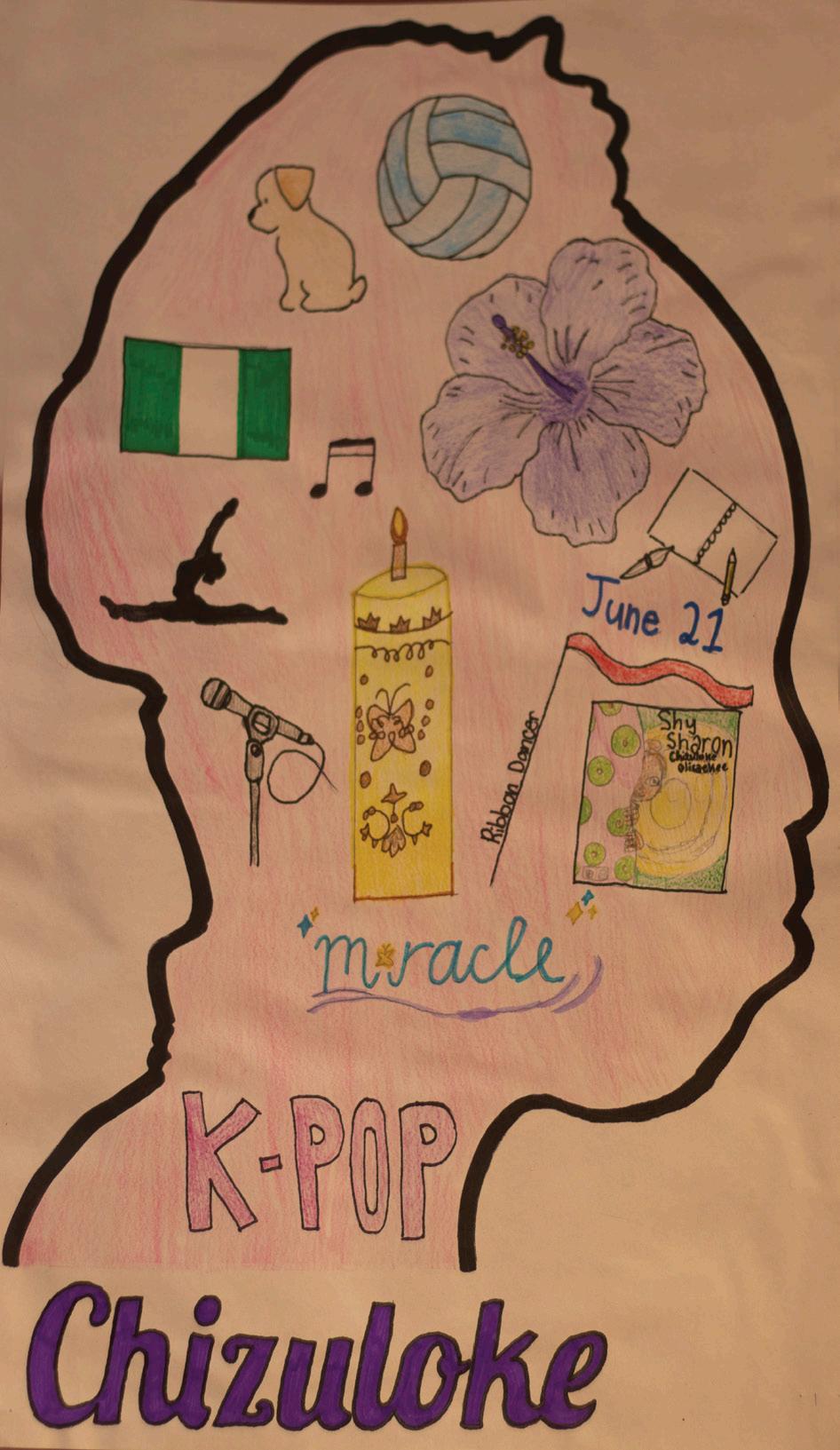




Content warning: This article mentions suicide. True inspiration, possessing both power and fragility, and capable of transcending assumptions to reveal an intrinsic spirit — the autonomous, technically adept, and sacred creations of AfroCuban printmaker Belkis Ayón (1967–1999) hold a wellspring of appreciating how one conveys one’s needs as an artist and as a human.
For those who regard art as the paramount language for the human condition, a retrospective of Ayón’s art is indispensable. She intimately comprehends the mechanics of infuence, reference, and exposition, seamlessly weaving the composition of life into art memorably.
Born in Havana, Ayón was an applauded printmaker and teacher active in the feeting decades of the post-modernist art period and the Período especial en tiempos de paz — a term that roughly means “special period in the time of peace” — in Cuba.
Even in her childhood, during an economically depressed period in Cuba, her talent was not overlooked. Starting at the age of 12, she attended prestigious art institutions in Havana and eventually became a teacher at Instituto Superior de Arte de la Habana (ISA), where she got her Bachelor of Arts in printmaking.
This kind of routine and discipline inherent in the practice of art cultivates true masters like Ayón. For any artist, discipline is a manifestation of spirit. There’s a symbiotic relationship between movement and representation, and that relationship underscores the inevitability of change within the artistic journey.
Collagraphy: Ayón’s medium of artistic expression
Ayón’s brilliant visual compositions cannot be separated from the socioeconomic landscape of Cuba during her time, particularly the tumultuous
Período especial en tiempos de paz beginning in 1991 amid the collapse of the Soviet Union. During this era, Cuba felt an economic and resource depression fuelling rationing and social demonstrations. The reality of this period made the reality of Ayón’s art indeed a poignant political response to the scarcity of resources, which compelled her to harness creative ingenuity to an intimate use of visuals and symbols in her work.
Her chosen medium was collagraphy, which she defned as an engraving process consisting of a type of printed collage formed from various materials arranged and pasted on cardboard supports. Collagraphy takes a lot of physical intricacy and a nuanced understanding of the texture that comes out of this art medium. One advantage of collagraphy is that it allows an artist to produce works in quantity during a period of fewer resources.
Through collagraphy, Ayón captured the essence of conficts caused by her reality and provided a powerful commentary on the human condition amid adversity. At this point, her work became more monumental in its composition, redrawing a space to confront the censorship, violence, exclusion, inequities, and power structures of late twentieth-century Cuba.
The sense of drama that unfolds in her compositions is portrayed by a range of lightness and darkness, which grows bolder in her work as she progresses in her artistic career. These monochromatic colours of black, white, and grey are employed to characterize the silhouettes of her symbols, where the inspired composition begins the mystery.
Ayón’s inspiration from West African spiritual traditions
Drawing from religious traditions of the Cross River region in West Africa, the Abakuá Society emerged in 1836 as a clandestine force among young Afro-Cuban men, particularly in Havana, as a defant response to the dehumanization of slavery and oppressive regimes.
Ayón leaned heavily on the mythology of

Abakuá, a society that was forbidden to women.
While researching its secretive practices, she encountered stories of the goddess Sikán — a woman “martyred by men to reclaim the sacred voice,” she explained in a 1993 interview. The symbolism of the fsh, coveted as a sign of wealth, resonated deeply within the Abakuá mythos; men sought to venerate and appropriate its power, sacrifcing the goddess Sikán and animal skin to make instruments that contained the sacred sound.
Through her exploration of these themes, Ayón illustrated a complete yet unseen imagery through the textures of the society’s symbolism, from her scenes of initiation rites to her salient portraits of Sikán.
Sikán, embodying the language and norms of a male-dominated society, serves as Ayón’s conduit to acknowledge the often overlooked but deeply felt presence of women within Cuban reality.
This dynamic relationship exposes the contradictions and complexities of collective memory.
Sikán’s legend, in many respects, morphs into a cautionary tale, reinforcing the marginalization of women within the Abakuá tradition, reminiscent of Eve’s role in the biblical narrative of original sin. Ayón subverts the Abakuán Sikán myth by ofering a critical, outsider perspective on a society and mythology dominated by men.
Her deliberate reinterpretation of this lore is acutely aware of the intersecting realities of history, aesthetics, culture, and language, inviting contemporary audiences to reevaluate their idealization of these narratives. Within the enigmatic folds of the Abakuá secret society of men and with the iconography of Catholicism, Ayon conveyed the complex composition of Cuba’s cultural and spiritual roots.
Strength and vulnerability in Ayón’s endeavours
Ayón’s dedication was not without burden, as her death by suicide at the age of 32 left a large void in the artistic landscape. Nevertheless, her
Divine Angubua Associate Comment Editor
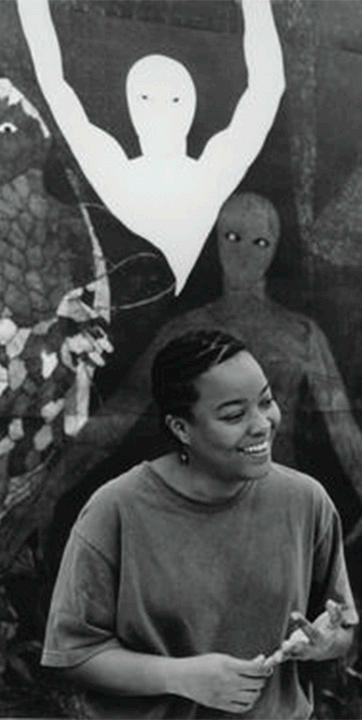
work and talent continue to cast a profound and mysterious aura, enveloping Cuba with a cloud of spirit that remains cherished and protected. Recognizing how an artist devotes attention to reality is a discipline that requires a great level of spirituality. In the enigmatic depths of the endeavours of artists such as Belkis Ayón’s lies a profound paradox of strength and vulnerability where the relentless pursuit of artistic expression converges with profound introspection, creating masked masterpieces that resonate with timeless power.
At frst, give thanks, for He makes all things new, Then clean your fruit for rot shall spoil the soul, Break gently as grace these roots of wrath, and watch for Time who feasts on tender fesh. Do not dwell on the price you paid for life when food is set, for regret makes the stew run cold.
Remember who you were when fullness was empty rooms where witches went to purge, the fesh of mango child, the heart of a lost sheep, Bring down the yams of labour now,
Let sweetness draw the juice of lust, And grind the grain of ghostly past, As spinach heeds to tears of brine, Like ichor at the starved altar, give with desert what your body has borne. There is wilderness within so wet and blue with night, Where gods with golden claws may hunt and demons dance beneath the virgin moon, Where, time was lost and you shall fnd me, Where, Cobalt fruit, golden seed, you wept as you consumed, There exists, a place where you fll up the deeper dark, With noise, and slick, and breath come apart, And it was good, For you have claimed it so. The bruised skin from which you bite, the forked creature that stalks in pale light,
Give thanks, for this was made for you.

 Xarnah Stewart Varsity Contributor
Xarnah Stewart Varsity Contributor
The 1979 release of the song “Rapper’s Delight” by the Sugarhill Gang marked a pivotal moment in music history, introducing the world at large to hip-hop and rap. Little did anyone know, at the time, the profound and lasting cultural efects these genres would have on the entire musical landscape.
Since the release of “Rapper’s Delight,” hiphop has evolved into a multifaceted cultural phenomenon, giving rise to diverse subgenres such as East Coast, West Coast, gangsta rap, conscious rap, and trap music. This evolution has allowed hip-hop to transcend cultural boundaries, becoming a global force that infuences music, fashion, language, lifestyle, and activism. Hiphop was and continues to be a platform for Black and other marginalized communities to amplify their historically silenced voices.
It’s not only the original lyrics of MCs that deliver a message of resistance; hip-hop also created the rebellious art of sampling. Sampling is a fundamental and distinctive element of hip-hop music production that has profoundly impacted the genre itself and the wider music industry. It involves taking a portion, or “sample,” of a preexisting sound recording and incorporating it into a new musical composition. This practice emerged as a creative and cost-efective way for early hip-hop producers to craft beats and create unique sonic textures.
The history of sampling
During the early twentieth century — both in New Orleans and elsewhere — jazz musicians frequently incorporated hooks, licks, progressions, or snippets of melodies from their fellow musicians’ compositions into their live performances. This practice was a form of homage — which is something that would continue in later in rap music sampling — that was rooted in a genuine sense of respect and admiration for the original composers.
The act of “borrowing” these musical fragments became a widespread tradition and it contributed to a playful and enjoyable atmosphere during live jazz events. This not only pleased the audience but also added an extra layer of enjoyment to the vibrant world of jazz performances.
With the evolution of technology, sampling went on to develop beyond its jazz origins. Some historians cite the invention of the Mellotron electronic keyboard and its predecessor, the Chamberlain, as some of the earliest pieces of sampling technology. But it wasn’t until the 1970s and the 1980s, starting with the mixing and manipulation of vinyls done by DJs and MCs in South Bronx, New York City, that sampling became the art form we know today.
Switching between two vinyls on two separate turntables during street parties and nights at the club, DJs would draw drum beats from one and vocals from the other, looping and playing the tracks over the other and seamlessly binding them together. Sampling was popular because it was cost-efective: all one needed was the vinyls they wanted to use and any two sets of turntables, which were extremely common and easy to fnd in the 1970s and 1980s.
Sampling for Black artists
American music critic Amiri Baraka argued in his essay “Technology & Ethos” that Black people in North America had to create their own technology to fnd liberation, since preexisting technology was often made to exclude the Black perspective. In fact, innovations in music often primarily occur due to the lack of technology that people have to reproduce the sounds they desire. Black people thus had to create their own sounds.
It is no wonder, then, that new technology began to emerge in Black communities in the 1980s through to the 1990s, after the Civil Rights Movement had used television
and radio to its advantage. Black artists used stretching and sampling in their bedrooms, and fgureheads like Herbie Hancock “hacked” the synthesizer to develop the sounds that he was looking for. New musical genres and styles emerged when Black people made room for themselves and adopted mainstream technology to create their own means of production and sound.
Sampling, one might argue, originated as a part of a resistance against mainstream forms of technology that excluded Black people. This might be why sampling, from the moment it became a powerhouse in the music industry, started to be seen as a threat. When it travelled beyond the neighbourhoods where it originated, the industry started trying to take it down almost immediately.
The death of sampling
Music never truly became commodifed until the rise of the Industrial Revolution and the creation of the phonograph. People stopped making music and started buying it instead, and music became less about music and more about money.
The lawsuit Tuf City brought against the Beastie Boys in 2012 showcases how the modern world prioritizes money in music. The record label Tuf City attempted to sue the Beastie Boys for using a drum sequence from the 1982 song “Drop the Bomb” by Trouble Funk in their song “Hold It Now, Hit It.” However, the lawsuit was fled by Tuf City without Trouble Funk even knowing, and a day before it was fled, one of the founding members of the Beastie Boys, Adam “MCA” Yauch died of cancer. Even after Yauch had passed, the record label did not back down, showcasing that the lawsuit was, above all, an aggressive grab for money.
This lawsuit, like many other aggressive sampling lawsuits, stemmed from a 1991 US District court case Grand Upright Music, Ltd. v Warner Bros. Records Inc., which made artists responsible for making sure they’d been granted permission from the original artist before sampling music.
This lawsuit changed hip-hop music forever. Before, artists had been able to build their entire albums from samples upon samples of other music without thinking twice. But the 1991 ruling led to the gradual decline of the artform; now, to sample, you have to be able to aford paying royalties to the original record label and artists — or to aford being sued.
This is why now, you only see people like Kanye West and Nicki Minaj pulling interesting
and recognizable samples out of their libraries and into their iconic albums. Artists like them do so as if to advertise their wealth. This made sampling inaccessible to most hip-hop artists, especially in hip-hop’s early days when most rappers and MCs were coming from less-thanfavourable circumstances. This, to me, rings true to the constant class oppression that society is always forcing Black people into.
But understanding what constitutes intellectual property and what counts as stealing is central to the legality of sampling. Sampling had been deemed okay when people did it during street parties where no one was making money, but it suddenly became near-criminalized the moment those same people started to make money from music.
As Craig Jenkins put it in his review of Public Enemy’s It Takes a Nation of Millions to Hold us Back , “Overnight it became forbiddingly difcult and expensive to incorporate even a handful of samples into a new beat… producers scaled back their creations, often augmenting one choice groove with a bevy of instrumental embellishments.” Even though the censoring of artists led to new sounds of East Coast rap in the 2000s, it still does not discount that the strict laws around sampling silence Black voices.
The criminalization of sampling, however, did not stop sampling as a whole. Just like the creation of the artform was made due to innovations, the continuation and perseverance of it also came through with innovations. No more than fve years after the landmark 1991 ruling, DJ Shadow released Endtroducing..... where he sampled dozens of songs throughout the album. He did so by distorting and reshaping the sampled music so much that he hoped people would fail to recognize it.
Enter stage left: PinkPantheress in her bedroom
Before she was PinkPantheress, in high school, Victoria Walker sampled songs on GarageBand and posted her remixes without the intention of making money. In terms of infuences, she cites her mother and “the UK music channel” for introducing her to garage, jungle and drum and bass music growing up, and even nods to K-pop as an infuence. She described her high school music to NPR as “a nice little hobby.”
Unexpectedly, her early career took of in 2021 due to the viral TikTok success of songs she built from interesting samples. PinkPantheress has emerged as a notable fgure in the realm of music sampling,
garnering attention for her distinctive and eclectic approach to blending genres. What sets her apart is not just the range of genres she explores, but also the skill with which she navigates and fuses these elements, creating a sound that defes easy categorization.
The two songs that led her to be a fan favourite — “Break it Of” and “Pain”— both sample UK club classic tracks that were recorded before she was even born. NPR identifed the samples: “Break it Of” uses a 1997 drum-’n’-bass track called “Circles,” produced by an English DJ named Adam F, and “Pain” samples “Flowers” by Sweet Female Attitude, remixed by Sunship.
When asked by iconic music reporter Nardwuar about how she fnds her samples, PinkPantheress replied that she just scours the internet and YouTube. This method has led to some critiques from individuals who accuse her of “defling the classics,” implying a tendency to draw from and tinker with well-known songs rather than explore more obscure or diverse samples.
However, PinkPantheress does far more than rework hits and has demonstrated a nuanced approach to sampling that challenges such criticisms. A notable example is her use of Franz Buchholtz’s “And Yet…” from an outof-print album by his band Signaldrift in her track “Noticed I Cried.” By selecting a sample from an artist associated with a bankrupt record label and featuring unreleased material, PinkPantheress showcases an ability to unearth hidden gems and breathe new life into obscure, forgotten sounds.
She is one of the many people who are trying to reclaim sampling. “People need to realize that sampling isn’t a new thing,” PinkPantheress told NPR, “Sampling is embedded into a lot of genres: EDM, garage, jungle, DnB, rap, hiphop.” Her perspective challenges the notion that sampling should be reserved for a select few and highlights the difculty in determining which artists should have the privilege to engage in this creative practice.
As she continues to make music under the record label Parlophone, PinkPantheress contacts the artists and other record labels to sample their music. While PinkPantheress is recognized as a trailblazer in music sampling, the future of music is a dynamic and multifaceted landscape shaped by various artists and infuences. As technology continues to advance and musical boundaries further dissolve, the exploration of diverse sounds and styles remains a central theme in the evolution of contemporary music.

As my home country Egypt sufers one of the worst economic moments of its modern history, I fnd myself asking whether it’s relevant to have the same conversation I have every other Black History Month: to remind you that Black Egyptians exist. Who cares when we’re all sufering regardless of race, ethnicity, or religious afliation?
Since the ongoing depreciation of the Egyptian pound that began in early 2023, the Egyptian economy has taken a major hit. Prior to the currency devaluation, 30 per cent of the country already lived under the poverty line, many of whom live in the southern parts of the country.
When I speak with my community members back in Aswan — the southernmost governorate of Egypt, which is home to many Black Egyptians — I realize just how bad it is. People I grew up with are forced to sell their jewellery and prized assets to make ends meet. Many I know have had to alter plans for their children’s education, and everyone I speak to is seriously considering immigration.
My childhood is marked by this unbelievable duality, one where I would travel between the metropolis of Cairo and the villages and townships of Aswan, seeing parts of Egypt that most Egyptians don’t even know exist. In my experience, the communities of Aswan live with poorer infrastructure, with few proper chances for education, and are often displaced by the state many times over: either directly, as in the case of our forced displacement to build the Aswan dam, or indirectly, where many of us had to migrate from areas like Aswan to Cairo for our mere survival. To be in Aswan means to be surrounded by resilient people, yes, but to be without basic necessities.
And then I would visit places like the North Coast, where rich Cairenes and all of the state’s

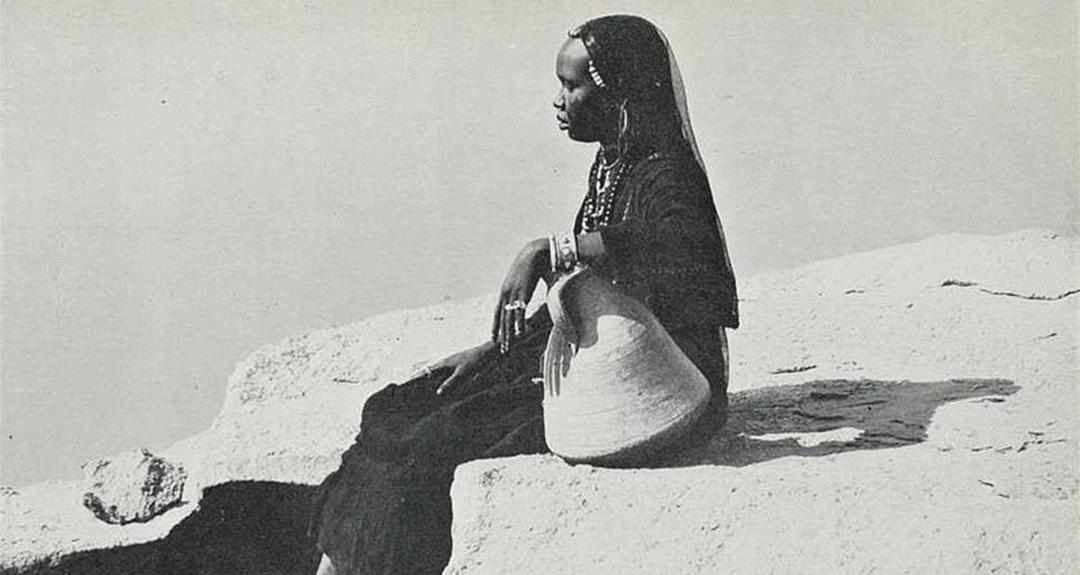
benefciaries have claimed ownership and treat it like some sort of Mediterranean playground. It always boggled my mind because this is the Egypt that they so heavily push in the media, while the other Egypt I know of is entirely omitted from the narrative.
I often think of how radically diferent my life could have been if my grandfather stayed in Aswan instead of migrating to Cairo. Would I have had the luxury of taking my sweet time to get through my degree while switching from major to major? Would I have even been fnancially capable of studying at a university, let alone a decent one? And now, as the country faces total economic collapse, I think of what price the people of Aswan have to pay that won’t be reported on and will be dismissed. Truthfully, the thought of that price scares me. And I fnd myself praying for all of us.
But we didn’t stay in Aswan. The fact that my words about my people’s experience are reaching you means that the sacrifces of my grandpa weren’t in vain — that his resilience paid of. The
Black Egyptian is not some sort of mythical creature nor some sort of docile sage. Black Egyptians sufer once through omission from the narrative of Egypt, and twice by belonging to it. So, for you, across the globe, to be able to sit with what that means for millions of people is a victory: a redemption for my people after years of sacrifce.
I recall the story behind one of my favourite songs: “El Leila Ya Samra.” The story goes that in 1962, Egyptian-Lebanese poet Fouad Haddad was serving time in prison, alongside many communists, political opponents, artists, and thinkers. Among them was Zaki Murad, a Nubian-Egyptian communist activist. Murad was spending another birthday in incarceration. The state of the country after its 1952 coup d’état, as well as the injustice and torture that befell him and his comrades, weighed heavily on him.
So, to cheer him up, Haddad wrote a poem about Egypt overcoming its dire challenges. He personifed Egypt as ‘Samra’ — an Arabic description for a dark-skinned beautiful woman. Nubian musician Ahmed Mounib composed a
song for the poem, and Nubian singer Mohamed Hammam sang it. Between the three men, “El Leila Ya Samra” was born to boost the morale of Murad and, by extension, their own morales.
To me, this story encapsulates so much of what it means to be both Black and Egyptian. We are tied to this country, have sacrifced a lot for it, and have fought for its betterment and freedom both internally and externally, but we have also often borne the brunt of its failures. Granted, we are not the only ones who have sacrifced, but the erasure of Black people in Egypt is its own violence.
Although hard times lie ahead for Aswan, she will overcome if we — like Haddad, Murad, and their companions — get through it together. She will overcome only if we see Egypt as who she is. Not the Egypt of the wealthy enclaves like Marassi and Tagamoa, but the Egypt of what we are made to believe are its fringes: the Egypt of Aswan, of Siwa, of Sinai. The Egypt of all those who don’t create the narrative but whose lives are shaped by what it omits.
On the evening of January 26, U of T’s Black Student Association (BSA) hosted an art show at the Daniels Building in collaboration with OCAD University’s Almeda Black Student Collective. The art showcase — Revival —featured work from U of T and OCAD students and demonstrated the abundance of talent at both universities. Highlighting the work of Black artists, the show featured an array of artistic mediums, including painting, sculpture, photography, and everything in between.
Hosted in the main entry hall of the Daniels Building, the showcase had a welcoming atmosphere, inviting both artists and spectators to mingle and connect throughout the night. Connection was a prevalent theme at the show, both on and of the canvas, as much of the artwork explored motifs of community and identity.
In an interview with The Varsity, Irene Olayinka, an equity ofcer for the BSA, noted that the artists’ mere willingness to come out and share such personal work is “very telling”: “If you want to have meaningful community, you must be vulnerable in some way.”
“Providing a space for vulnerability has been really conducive to creating this community [for artists],” she added.
Vulnerability and introspection seem to have been pouring from the brushes of many of the event’s painters. One artist who showcased their work, Zenzele Shange, presented a self-refection portrait composed over four years, representing the struggles the artist experienced with identity throughout the COVID-19 pandemic.
Chimemelie Okafor presented their piece
“Posterity,” which is equally as vulnerable and identity-focused but takes a diferent approach to the theme. “Posterity” is a unique adaptation of Nigeria’s coat of arms featuring the artist’s face.
According to Okafor, their painting nods to their perspective on Nigeria’s ongoing political and economic crises and serves as a call to action to protect future generations through changemaking.
The variety of artists’ depictions of their identities was fascinating. Some artists, like Shange, portrayed themselves through periods of profound personal struggle, change, and growth, while others, like Okafor, addressed their personal stakes in political issues.
According to Olayinka, one thing that the artists at Revival shared was a collective struggle for recognition in the art sphere. “Black artists are often overlooked, underrepresented, and not properly acknowledged,” she said. The issue of distinguishing Black artists and their work within the broader art community was a topic of major interest in my discussions with Revival’s organizers.
Regarding Black students’ participation in art, Olayinka made the point that being a Black student in a predominantly white institution means that your work is “fltered through the lens of ‘you’re doing an activity, but you’re a Black person doing that activity.’”
Vanessa Mutai, the BSA’s vice-president internal, agreed with Olayinka, remarking that “often when Black artists engage with art, they’re put into the box of being a Black artist frst.”
Mutai pointed out a series of portraits by AY Johnson as an example: “I think in any other space you would be focused on [the subjects’] Blackness above anything else, rather than seeing them as portraits.” The series Mutai referred
to, by Johnson, is titled “Itumọ.” Itumọ means “translation” in Yoruba, refecting the artist’s intention of representing Yoruba mythologies and heritage through her eyes. The subjects include AY’s brother and friend.
Mutai’s comment highlights the danger of exclusion when considering Black art solely through a racial lens and diferentiating between the labels of ‘Black art’ versus ‘art.’ At Revival, Johnson’s portraits were given the chance to be appreciated as nuanced portraits rather than only as portraits of Black bodies.
In their work, the artists at Revival did not focus solely on what it means to be Black. Femininity, for example, was the key theme in Eira McIntosh’s “Florid.” McIntosh collected materials for the piece over a long period of time, and the result is a crafted necklace with a large scavenged skull as its pendant. The piece is meant to question preconceived ideals of femininity, contrasting ornateness and darkness.
Mozelle Ofori-Atta, an architecture student at U of T, created the installations “Mylar Façade” and “Density.” She brought together her passions for visual art and architecture to exhibit these pieces, which she originally submitted as assignments for her architecture program. She made “Density” using 3D printing, and “Mylar Façade” by using laser cutting techniques on mylar sheets.
When asked about the overall goal of Revival, Oyindamola Dina, one of the BSA’s education and outreach directors, explained, “We like to showcase the diferent aspects of Black culture from diferent continents, countries, ethnicities, and all across the diaspora.”
By this measure, Revival was immensely successful — it saw pieces inspired by various cultures, themes, and interests. Through their participation in the showcase, artists had the opportunity to share the stories behind their work, gain recognition among their peers, and build a community centred on their art and the experiences that infuence it.
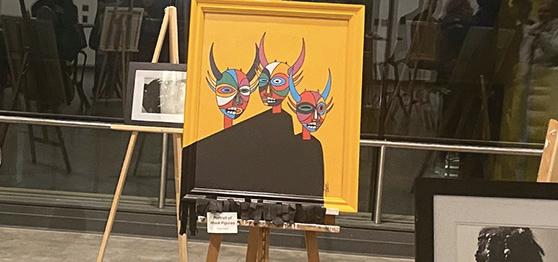

 Xarnah Stewart Varsity Contributor
Xarnah Stewart Varsity Contributor
Content warning: This article discusses anti-Black racism, and includes vulgar and explicit anti-Black racist language.
On November 19, 2023, news broke out that English actors Suki Waterhouse and Robert Pattinson were expecting their frst child. Congratulations to them, but this announcement led me and the rest of Gen Z who are invested enough in celebrity drama to recall Pattinson’s previous relationship with singer-songwriter FKA Twigs. Pattinson and Twigs were together throughout the 2010s, then abruptly ended their relationship in 2017.
Unlike the recent drama between celebrities Selena Gomez, Justin Bieber, and Hailey Bieber — which sparked TikToks about Gomez’s and Bieber’s eyebrow styling choices on their Instagram stories — the relationship between Pattinson and Twigs instead sparked a conversation about the realities of interracial couples.
A few years prior, there was the relationship-turned-marriage between Prince Harry and Meghan Markle, the frst interracial couple — and possibly the last — in the British royal family, who have recently become parents to two kids. It is these two relationships in particular, I think, that exposed white Gen Zs to the seemingly unchangeable fate of interracial couples. The microaggressions and macroaggressions brought down upon Twigs and Markle for being Black women in a relationship with white men are refective of the societal barriers put up for non-famous, everyday people in interracial couples.
These issues can arise even for some of the most watched people in the world; even the richest and most untouchable are, in fact, touchable. While all celebrities can be torn down from their
the perspective of a nobody such as myself, or the perspective of celebrities, the experiences barely vary.
The downfall of Pattinson and Twigs’ relationship and the current news of Waterhouse’s pregnancy, for me, should prompt a profound examination of interracial relationships within the celebrity realm, because of how it sheds light on the complexities of macro and microaggressions that such couples face.
afects how we love
In the podcast Forbidden Fruit with Julia Fox and Niki Takesh, Twigs recounts her experience growing up in a small British town as one of the only people of colour. She says: “When I was in year seven, there was [only] one boy in sixth form that was Black as well,” and that this classmate, who was mixed-race, was considered among their peers to be “hot” while she, the mixed-race girl, was not.
This is the plight of women of colour in predominantly white neighbourhoods, rooted in slavery and colonization. Black women are often seen and portrayed as masculine. bell hooks, in her book Ain’t I a Woman, brings to light how the Black woman was “exploited as a laborer in the felds, a worker in the domestic household, a breeder, and as an object of white male sexual assault.” Over time, this evolved into the “Sapphire” stereotype that depicts Black women as overbearing and masculine.
This stereotype often plagues Black women both in fctional media and press coverage, and in everyday spaces like educational institutions and workplaces. In their 2015 article “Perceiving the Black Female Body: Race and Gender in Police Constructions of Body Weight,” Naa Oyo A. Kwate and Shatema Threadcraft mention that empirical evidence demonstrates “confation in the White American imaginary of whiteness with female, and blackness with male.” Thus, because the ‘Sapphire’ caricature that runs rampant in the media constructs them as “rude, loud, malicious, stubborn and overbearing,” Black women are seen as undesirable because they are stereotyped as “emasculating.” Perhaps this explains Twigs’ experience with being deemed as “other,” as it might explain mine, and that of many other Black women.

Twigs was shocked, as so many of us were, to realize the root of the diferences between her and the rest of the people at her school. While almost everyone else was white, she was not, and therefore automatically considered less attractive. It was not only because of her Blackness but also because she was a woman.
This experience is pivotal, yet far too common, continuously shaping the lives of children and adults of colour everywhere. It is why so many of us grow up thinking that we are incompatible with our peers and, worse, that we are ugly — that we are unworthy of the love everyone around us gives and
Even now, when I scroll through my TikTok page, it feels as if our generation is regressing.
As internet users begin to embrace and reminisce upon their girlhood again, it seems to me that it is accompanied by anti-Blackness — specifcally, the rejection of Black women, my own femininity, and my own childhood experiences of both joy and rejection.
Take a minute to watch a TikTok slideshow displaying the beauty of girlhood; take another second to watch fve more. How many of these slideshows include women of colour? How many of them include Black women? Almost all these slideshows depict skinny white women draped in frilly dresses with bows in their hair. If they want to avoid being accused of white normativity, they throw in one glimpse of an Asian or brown woman. It leads me to wonder if I can ever be loved, especially by people outside of my own race.
For me, growing up in a predominately white town meant skip-roping to songs; the smell of mud on my fngertips; jumping into puddles; and watching the snow fall with my
face pressed against the window and my sister buzzing excitedly behind me with both our snow pants in her hands.
But it also meant hating myself and my hair. It meant teachers telling me to stick to soccer and track because I was fast. You’re fast, strong legs, they said. It meant my teachers, principal, and other parents implying that I was neither smart nor respectable enough. It meant tearing my hair out of my scalp and blaming my big nose and my skin for my ugliness. It meant that I was treated more grown up earlier than everyone else. It meant my body and identity were constantly scrutinized and picked apart when I was only twelve.
For other people, it might have looked dif ferent. Maybe it was people commenting that your name sounded weird coming out of their mouths, or teachers asking where you were peers scrunching their noses up in disgust when they smelled your food at lunchtime. The act of constant os tracization. As James Baldwin put it in his memoir what one does realize is that when you try to stand up and look at the world in the face like you had a right to be here, you have attacked the entire power structure of the Western world.”
This scrutiny haunted Twigs at the start and end of her relationship. To an extent, the same can be said for Markle and her relationship with the royal family.
This, of course, sets the example for interracial couples’ experiences. These two couples navigated the diferences and problems that in evitably accompany celebrity inter racial marriages, both featuring a light-skinned Black woman and a British white man. These two couples were publicly scrutinized for months, primarily because they were interracial couples who de fed preconceived notions of what people wanted and ex pected from the white man.
Women on the verge of a breakdown — but, prise
The hardships accom panying Twigs’ and Meghan’s experiences with dating and mar rying white men have been amplifed due to publicity. They were not just dating white men — they were dating the Prince of

England and Edward Cullen. Their fans, or the British royal family, were quick to criticize their every move.
We watch celebrity couples face public scrutiny all the time — from Gigi Hadid and Zayn Malik to Kylie Jenner and Timothée Chalamet — but racial biases separate interracial couples. Black people already face an unrelenting amount of public attention simply because they are Black. It was not Pattinson himself who initiated the public scrutiny that burdened Twigs from the start of their relationship, but rather his fans and the rest of the media.
Moreover, despite the hatred and racism that Twigs encountered, for a long time, Pattinson never said anything to encourage his fans to stop. His silence at the time was deafening. Twigs recounted the relationship in what is now a famous quote in an interview on Louis Theroux’s podcast Grounded: “He was their white Prince Charming, and they considered he should be with someone white and blonde and not me.” Of
baby is, of course, ridiculous and belittling in general, but the conversations surrounding the publicized comments made by members of the Royal Family fail to address the other microaggressions that she experienced in Buckingham Palace.
Markle also did not receive mercy from the tabloids. Since she became intertwined with the royal family, everything Meghan has done has been criticized and picked apart by media coverage — more than her sister-in-law Catherine, Princess of Wales and formerly known as Kate Middleton, and more than her deceased mother-in-law Diana, the former Princess of Wales. This is the constant pattern that women of colour in high-level positions must face.
Has a partner of a diferent racial background than you ever professed their love for you, only to pivot and choose to date a white woman instead? This is a common coming-of-age event among Black women.
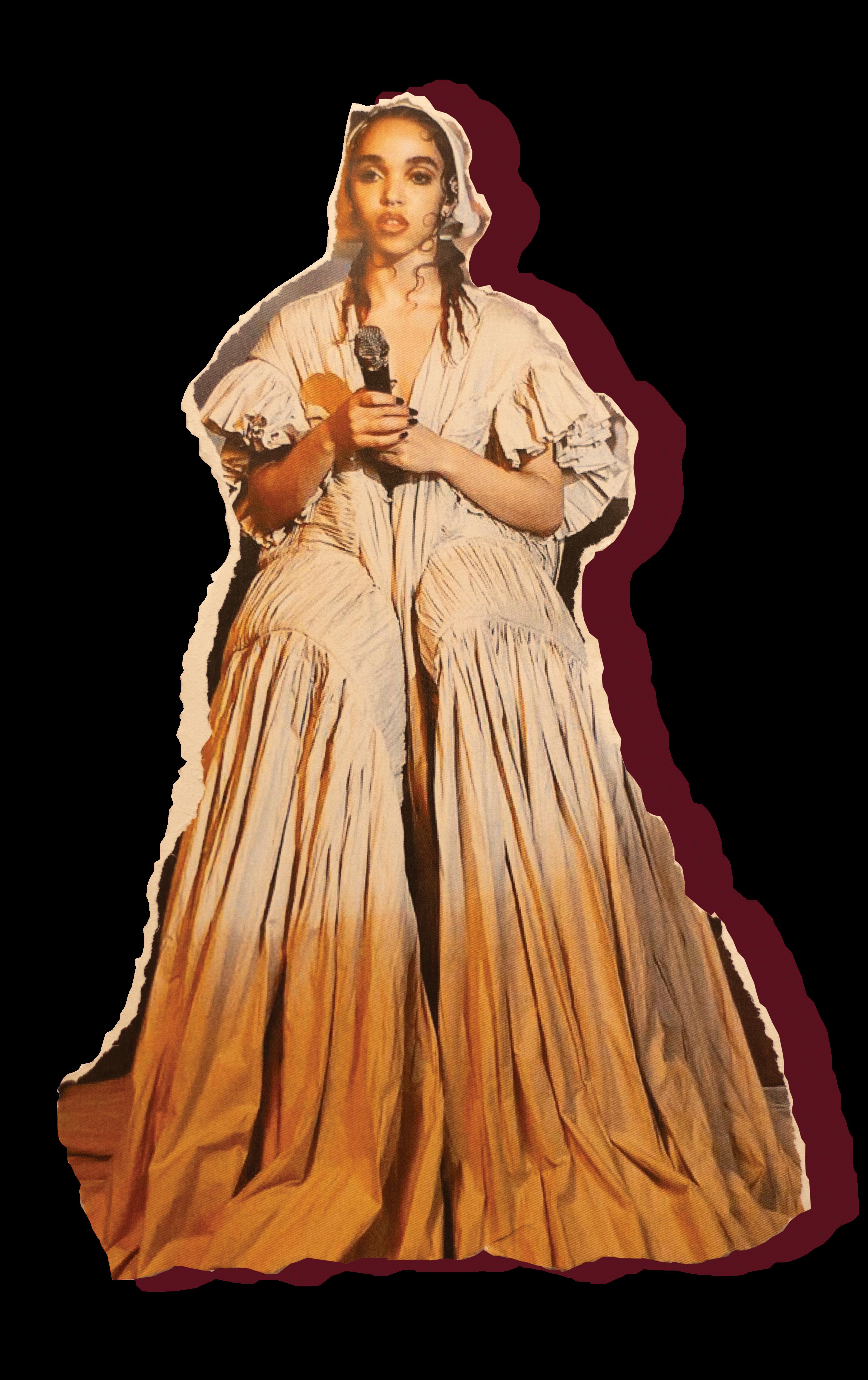
For example, in one tabloid article, Markle is described as having “exotic DNA” and in another, the headline reads, “EXCLUSIVE: Harry’s girl is (almost) straight outta Compton: Gang-scarred home of her mother revealed - so will he be dropping by for tea?”
Then there are articles about Catherine. In one from 2007, when she was still known as Kate Middleton and the newest member of the royal family, Oliver Marre wrote, “The prince and his girl were frst pictured together in April 200 , on the slopes of Klosters. Since then she has evolved from a fgure of feeting, firtatious interest ‘ inners at Highgrove, trysts at Bal moral’ ‘Finally, Wills gets a girl ’ to a fully-fedged obsession ‘Kate Can Save The House Of Windsor ’ .” The diferences are stark — Markle here seems to be confned to her race.
In contrast to Patterson, according to TIME, Prince Harry “released a public statement via Kensington Palace in defense of Markle’s privacy and safety, where he called out racist and sexist press and social media” when they frst started dating. He continued doing so after their marriage and the birth of their son Archie.
I am not arguing that there has to be a — in this case, literal — knight in shining armour to save women of colour in times of peril, but both members of interracial couples must be prepared for backlash. You can say what you will about Prince Harry, but he was committed to Meghan and prepared for the public scrutiny they have had to overcome by being together.
Let’s hear it from normal people now
What seems to me to be the true problem of Twigs’ and Markle’s stories is not the white man themselves but the barriers that surrounded their relationships from their conception.
Most interracial couples that have spoken about their experiences have faced some sort of racism, whether through covert or overt discrimination. For example, Margaret Wilkerson Sexton, a contributor to The Guardian, explains that people “often assumed [she] was [her] boyfriend’s prostitute; they called him sir and looked at [her] with disdain.”
Furthermore, the couple frequently encountered racial mi croaggressions in their social circle that her husband tends not to notice. For example, one white female friend remarked that exclusively dating white women with natural blond hair is indicative of “higher standards” of dating preferences. So, not only were they masculinized, but they were also made to be sexual objects — as Jezebels.
According to a 1999 article by Anita Kathy Foeman and Teresa Nance, literature on interracial couples demonstrates that when observing a relationship between a Black person and a White person, many people assume psychological issues, such as “(a) Black sexual acting out, (b) Black status-seeking, and (c) White neurotic acting out.”
bell hooks describes that white colonizers, in the process of colonization, painted Black girls as overly desirable to the male eye from an early age and as “the embodiment of female evil and sexual lust.” One time, while I was on a date with a white man, another man approached him and asked him if he “liked Black pussy.” Another time, a man came up to me on a date and asked where I was from. I responded quickly, “My parents are Trini, if that’s what you mean.” He looked at my date and asked if he liked me because “I was a little bit of everything but Black enough to be cool.”
These are all comments that are now easy to ignore simply because I have learned that they are unavoidable — this is the reality of interracial dating. When you are standing next to someone who is not the same race as you, you become more obviously the race that some people fear. Even more so, as a Black woman standing next to a white man, in the case of Twigs, Markle, and other women, you become Black with scary connotations.
Has a partner of a diferent racial background than you ever professed their love for you, only to pivot and choose to date a white woman instead? This is a common coming-of-age event among Black women. Some people brace for it, but a lot of the time, it catches us by surprise the frst time it happens.
Or, perhaps they instead broke your heart by revealing some frightening opinions about “your people” or even a diferent population of marginalized identities. One day, they might say, “They should put Black women at the front of every store because people don’t fuck with Black women.”
You might be scared to ask what they mean because, deep down, you know exactly what they mean.
Yet you ask, and they say, “Because Black women are scary. Not you of course. ou’re diferent. ou’re cute.”
You should have ended it right there.
But you don’t. Because what did you expect? And if it’s not them, it’s the lack of understanding that they have about race and racism. Or maybe it is their families and their comments about you when you’re not around. Really, what did you expect?
The reality sets in: interracial relationships come with many and
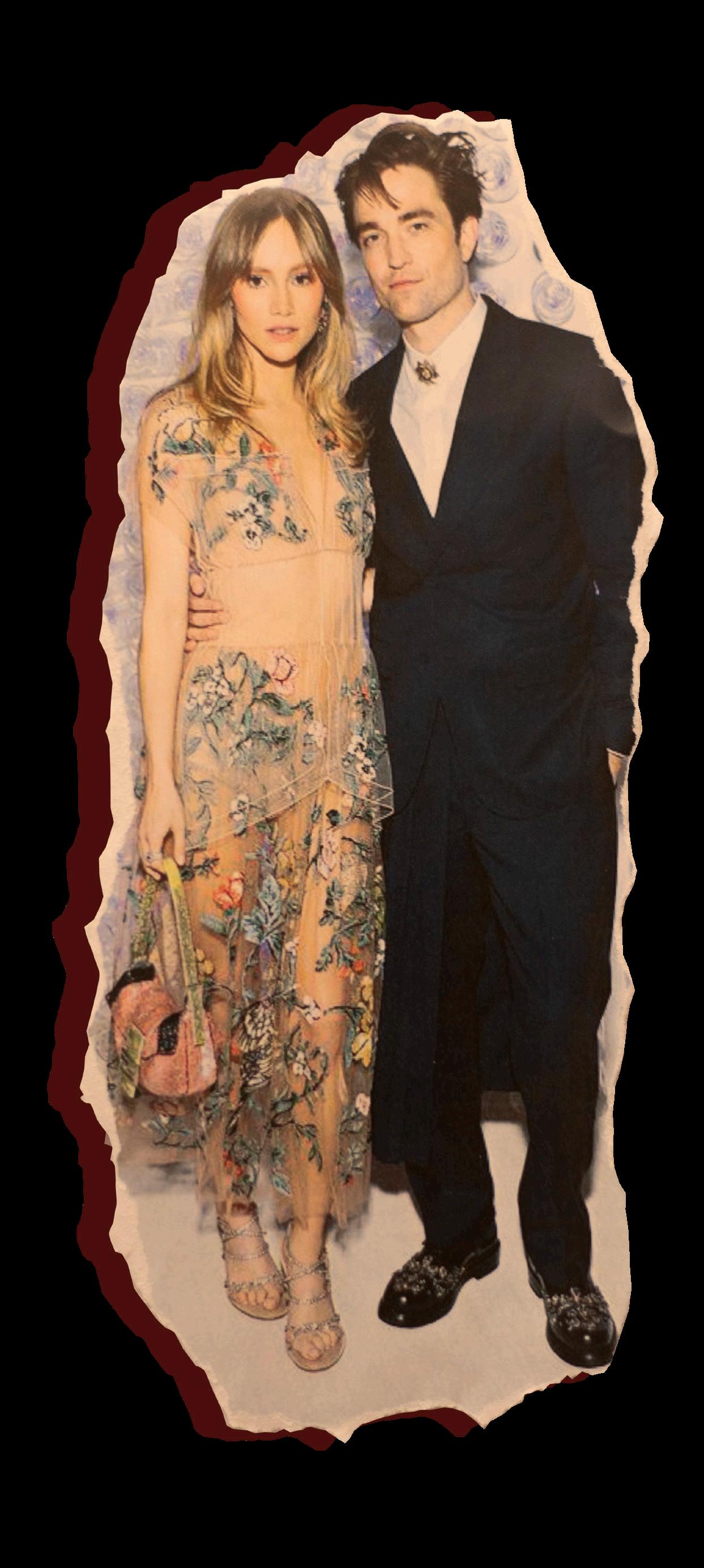
While Canada presents itself to the world as a nation whose history is untainted by the harsh reality of the enslavement of Black people, this is far from the truth. In 2009, former Prime Minister Stephen Harper once said that Canada has “no history of colonialism.” I’ve seen many Canadians unaware of the fact that Canada has a long, harrowed history with Black people that dates back to around 1629 when European settlers brought the frst enslaved people to Canada.
As I write this article, I must admit that I am still in the process of learning Canada’s history with Black people. However, understanding this history is crucial to exploring the signifcance and evolution of Black History Month (BHM) in Canada.
Americans have celebrated BHM since President Gerard Ford ofcially recognized the month in 1976, right after the peak of the Civil

Rights Movement. On the other hand, Canada has a comparatively shorter history of recognizing BHM that dates back to 2008, when the Senate approved to ofcially recognize the month. To me, the rise of the Black Lives Matter movement in 2020 ignited a spark that I believe began Canada’s larger social recognition of BHM.
In February 2019, a group of students and I presented a campaign in our high school in Saskatchewan to raise awareness about BHM. We were met with backlash from the faculty and told that celebrating BHM was “unfair” to other ethnic minorities. This sentiment is common among Canadians and extremely problematic because it sets the precedent that Black Canadian history is irrelevant.
Celebrating BHM in Canada does not diminish the identities and experiences of individuals from other ethnic groups. Rather, it is a month to acknowledge the history and contribution of Black people in Canada. A little more than a year after

we must start with
our campaign, following the killing of George Floyd, it seemed to me that my high school suddenly realized the importance of BHM — as many other Canadians did.
It should not take a tragic event for people to realize the importance of BHM. George Floyd did not need to lose his life for the world to open their eyes to the realities of the experiences of Black people. But unfortunately, that is what happened. Although Canada acknowledges BHM, I believe there is still a long way to go in educating Canadians about the history of Black people in Canada.
A fractured history
I’ve noticed that many are shocked to fnd out that Canada practiced slavery for over 200 years, enslaving over 4,000 individuals of African descent. Although Nova Scotia was a settlement for formerly enslaved individuals, Black people in Canada were not always free. Many enslaved people were brought into “New France” — now Canada — starting in 1628, and they later settled in Nova Scotia.
Today, African Nova Scotians still face many health and social disparities because of the centuries of hardships they sufered and because of existing systemic racism. Additionally, Ontario and Nova Scotia had legislature supporting racially segregated schools. It was not until the Canadian Human Rights Act was passed in 1977 that racially segregated schools began to close, with the last one closing in 1983.
In a 2019 interview with CBC, historian Afua Cooper calls Canada’s silence about slavery an “erasure of Blackness,” and I agree. Generally, Canada has hidden its unpleasant history with people of colour in the name of presenting itself as a peaceful country where everyone is free to be themselves. This is not the reality.

The UTM library’s launch of 31 books by Black authors recognizes a Black literary canon
Divine Angubua Associate Comment EditorAccording to Statistics Canada, Black populations of African, Caribbean, and Canadian descent, on average, earn between $2,900 to $8,000 less than their non-racialized peers. Black people are also more commonly unemployed, more likely to encounter disputes with the law, and more likely than their non-racialized peers to experience discrimination.
However, the likelihood of racial discrimination varies depending on educational achievement.
According to a Pew Research Center survey, college-educated Black Americans report fewer experiences of racial discrimination. Racial disparities exist at every level, but the pursuit and opportunity of education and literacy come as a saving grace against a deeply fawed system.
Therefore, on the frst day of Black History Month, it felt right to celebrate Black literacy.
At 1:00 pm on February 1, Black at UTM — an initiative born from U of T’s Anti Racism Task Force recommendations — partnered with the UTM library to honour and celebrate Black literary excellence. I attended the event, called “Black on the Shelf,” which launched a collection of 31 books written by various Black authors into the university library’s catalogue. The books had been carefully chosen by Black students and faculty, and were displayed at one end of the space, overlooking a number of faculty, students, and staf mingling,
conversing with each other as they interacted with the texts.
The event reinforced the power of harnessing education and language as tools for telling our own stories, making space for ourselves, and defending ourselves against those who wish to harm us.
I have long believed that in pursuing freedom and challenging oppression, we must start with promoting literacy, and redefning good literature for ourselves. For Black people and other racialized groups, we must dismantle the sacred colonial texts within classrooms and replace them with a body of works through which we are all seen and through which we can all engage equally.
Universities are cultural pillars that inform society’s norms around race, democracy, and welfare. Out of them, tomorrow’s leaders, civil servants, and stakeholders are licensed to inherit the world, and they must be certifed to have the right materials, methods, and concepts to govern society.
Given that literacy and literature are two factors of the greatest importance in the struggle for the emancipation of Black people across the globe, centring them in discussions and celebrations around Black History Month marks progress.
As Frederick Douglass said, “Once you learn to read, you will be forever free.” In his memoir The Narrative of the Life of Frederick Douglass, Douglass testifes that by learning to read, he gained the power of truth over the conscience of his slaveholders, a view of the pit of his condition, through which he could build a ladder and fnally escape.
While Canada is making steps towards reconciling the disparities that Black Canadians face, there is still a signifcant gap in our knowledge of the history of Black Canadians. When asked about the history of Canada in a class survey, only 26 per cent of UTSC students in the PSYC12 — Psychology of Prejudice and Oppression class I took in the winter of 2024 were aware that Canada has an over 200-year history of slavery.
What can be done to address it?
As an immigrant to Canada, it has been important for me to educate myself about Canadian history. I believe that all people who have the privilege to live on Indigenous land should do their due diligence to understand the history that has led us to where we are as a nation. The Canadian government — specifcally the Canadian Museum for Human Rights — has helpful resources about Canada’s history.
Additionally, U of T has courses such as UTSG’s HIS265 — Black Canadian History that detail the history of Black Canadians and what that history means for Canadians today. While Americans are stereotypically “louder” than Canadians, I believe their “loudness” has allowed them to spread awareness about their history. Canadians need to be loud too. Canada has set a precedent to be neutral and peaceful, but sometimes that passes of as apathy. We need to be louder and amplify the voices and history of Black Canadians.
Black Canadians have been extremely infuential and benefcial to the nation, and it would be a shame to disregard what we have brought to the table. Looking ahead, I am hopeful that we will live in a nation that acknowledges and celebrates Black History Month genuinely and not to save face. While we have made strides in the last few years, Canada needs to step up and educate its people about the history and ongoing challenges Black communities face. It is my hope that this collective efort will foster greater understanding, empathy, and solidarity, leading to a more inclusive and equitable society for all.
Ewa Akomolafe is a fourth-year student at UTSC studying psychology. She is the co-president of UTSC’s Future Black Physicians Club.

In one of the books launched — Toni Morrison’s The Source of Self-Regard — Morrison questions why American literature, by defnition and convention, is set aside from African or Asian-American literature. She boldly challenges the white men origins of academic measures of literary and humanistic value, as well as aesthetic criteria; the fact that historically, contemporary literary discourse and production has been “the protected preserve of the thoughts and works and analytical strategies of white men.” She highlights how when we think of great American or British literature, we think of names such as Ernest Hemingway, T. S. Eliot, F. Scott Fitzgerald, William Faulkner, and Mark Twain.
What “Black on the Shelf” did refects Morrison’s argument against the conventional literary canon. The event felt like the creation of a literary canon for Black people, by Black people, composed of Black people. This is important for the ways in which these books may guide other Black people to perceive themselves and the world, and the ways in which the wider world is opened up to the vast range of stories and complexities in the lives of Black folks.
In UTM’s case, this Black literary canon comprises books like Gayl Jones’ novel Corregidora, a strange, unsung classic that explores the deeprooted efects of generational trauma and genderbased violence through the fraught sex life of one Black woman. There’s also Marlon James’ A Brief History of Seven Killings, which novelizes Jamaica’s bloody political life in the ’70s and the CIA’s plot to
assassinate Bob Marley. There is Mikki Kendall’s Hood Feminism, as well as Dennis R. Edwards’
Might From the Margins which explores how the Christian faith has historically fueled the mission for liberation in spite of the pro-slavery theology of early American Christian identity.
These are books that present new ways of thinking and modes of being — an ethos that is refected in the growing phenomenon of Black studies programs at Canadian universities like York, Queen’s, and Toronto Metropolitan University. This trend of Black studies programs must be partnered with lasting infrastructure for the support, care, and promotion of Black students, staf, and faculty alike.
Keep adding Black authors to libraries, Black studies programs to curriculums, and accepting Black experiences as worthy scholarly inquiries. This way, we give ourselves the means for protection and nurturing by engaging with Black literature as world literature, and the discourse around it as worthwhile education. In compiling a canon to which we may reference and upon which we may refect, we may give ourselves the power of truth over the conscience of the institutions that we serve, and forge paths to freedom for ourselves and others like us.
Divine Angubua is a third-year student at UTM studying history, political science, and creative writing. He is the editor-in-chief of With Cafeine and Careful Thought and a staf writer at The Medium. He is an associate comment editor at The Varsity.

Research at academic institutions must be aware of its broader societal impacts Why it’s important for researchers to think bigger than themselvesErinayo Adediwura Oyeladun Varsity Contributor
I am currently enrolled in HIS265 — Black Canadian History — at UTSG, taught by the exceptional Professor Funké Aladejebi and assisted by Arshad Suliman. In this course, I was introduced to the phenomenal scholarship of Barrington Walker, a historian of modern Canada whose research focuses on the histories of Black Canada, race, immigration, and the law.
We studied his featured article, “Critical Histories of Blackness in Canada,” in the 2022 book Unsettling the Great White North: Black Canadian History, co-edited by Aladejebi and York University Professor Michele A. Johnson. In his article, Walker urges Black Canadian historians to ask the question, “what do we want Black history to do?” in research. He urges historians to use their work as a means through which they can help the Black Canadian community “secure the liberation of Black peoples from the terror of the racial state.”
I highlight Walker’s scholarship here because it raises awareness of the importance of understanding that research has more purposes than knowledge production. I believe his work pushes scholars to think of their scholarship as bigger than themselves and be cognizant of the impact of their work — particularly when it involves representing the cultures, ways of being, and lives of people within communities that the work centres on.
Why thinking bigger than yourself is important
Drawing on another exceptional work of scholarship, Amanda L. Logan, in her book The Scarcity Slot: Excavating Histories of Food Security
in Ghana, talks about how anthropologists, in the past, had consistently made ignorant assumptions about food systems in Africa because of their assumed racist perception of Africans and the African continent. Colonial legacies, as a result of imperialism, have evaded critical analysis by researchers when it comes to investigating and addressing issues of food insecurity in the African continent.
Logan notes that ethnographers, anthropologists, and archeologists should combat these harmful misconceptions, as they afect policies and plans that are deployed on the African continent. For example, international bodies, informed by these common misconceptions, seek to solve food insecurity in Africa by making active eforts toward increasing food production rather than acknowledging that high food prices are what hinder food accessibility for those most vulnerable.
I believe Logan’s work provides an essential empirical example of the importance of thinking bigger than yourself and beyond what your work does for your career. These assumptions and ideas around Africa — which Logan points to having been reproduced through many scholarly works — have had far-reaching consequences on how nations are treated on the international stage and how misconceptions of them are entrenched into the ways people within the communities think about their individual identities.
Thus, thinking bigger than yourself demands that researchers be aware of the broader implications that their work serves and encourages a more refective and responsible approach to academic work, understanding the broader implications it has on a global stage.
Similarly, Joseph Hanlon argues in his article, “Power Without Responsibility: The World Bank & Mozambican Cashew Nuts,” that the conception
of African governments being incapable of pursuing pragmatic development policies has played into the ways aid is deployed in African countries and the Global North’s choice to deploy aid to non-governmental organizations (NGOs) rather than national governments.
In Mozambique during the late 1980s, the oversaturation of NGOs completely stripped the nation of political sovereignty and the ability to pursue economic development policies that advocate solely for capitalism and market economies. These ideas of African politics and economies in academic research have signifcantly shaped how
Africans are perceived in the global world and even sometimes how Africans perceive and seek to solve problems within their environments. Walker’s work reminds me in my research to always think about how our academic work afects how people within our community are perceived. Research can be critical and based on empirical facts, but I believe it can also be empathetic. Researchers should remember and be aware that the people they talk about and represent in their scholarship are afected by their choices and the facts and opinions they report. Academic institutions put researchers in a space of power, and this positionality allows them to defne the peoples and communities that their research focuses on in a larger global context.
Erinayo Adediwura Oyeladun is a second-year student at Trinity College studying African studies. She is the director of education and outreach for the African Studies Course Union.

 Ezinne Arki Varsity Contributor
Ezinne Arki Varsity Contributor
As the treasurer for the club Black Doctors of Tomorrow (BDOT) at U of T, which supports Black students who aspire to work in healthcare, I have traversed the tribulating road of seeking funding. As a club starting anew after a COVID19-induced years-long hiatus, we have been confronted with the unfortunate reality that, in the face of a wave of Equity, Diversity, and Inclusion (EDI) initiatives, there is still a lack of sufcient fnancial support for new student organizations that support marginalized communities.
Black people in STEM?
Black students remain underrepresented in STEM, and life sciences at U of T is no exception. I believe that many Black students within life sciences programs at U of T would agree that in lectures, tutorials, labs, and other academic environments, they are often the only Black person in the room or are one of few. This disparity in representation extends beyond the undergraduate level and further reveals itself in graduate and professional programs and the industry at large.
BDOT is the only Black premedical organization at U of T. We work to create a community among Black life sciences undergraduates and support them in their pursuit of careers in healthcare to help address the underrepresentation that aficts our community.
Unfortunately, this pursuit sufers when funding is scarce.
Securing funding
I’ve seen that certain clubs have advantages over others in acquiring funding. Some student groups and organizations that represent course
unions or departments receive departmental funding each year, which provides a cushion for the clubs’ preliminary operations before they receive other funding.
While any UTSU-recognized club can apply for UTSU funding, the UTSU states that “Desirable Applications” are ones from clubs which generate revenue, have a good history of fnancial management with the UTSU, and have a large membership compared to other funding applicants.
This poses a unique barrier for clubs that support marginalized groups on campus, as we naturally have a smaller membership and are not revenue-generating in an efort to remain equitable. Furthermore, the UTSU Clubs & Student Groups Handbook expands that clubs can only receive a maximum of $6,000 from the union, and if you are eligible to receive the maximum amount, UTSU funding can only represent 30 per cent of your expenses. Essentially, the more money you need, the more you are expected to already have.
Obtaining grants presents another issue. Although U of T ofers many grants available to student organizations, receiving this funding is not guaranteed, and committees receive many more applications than they can support.
Other funding sources such as the Student Initiative Fund are reimbursement-based, or may ofer a fraction of requested funds ahead of time and reimburse students for the rest after hosting an event. This requires club executive members to contribute hundreds or potentially thousands of dollars of their own personal fnances to support the club’s operations before reimbursement.
The University of Toronto and EDI
In acknowledgement of EDI, U of T states on its website, “From creating pathways for under-represented students to ofering anti-racism and bias
training for the U of T community, advancing EDI as a shared responsibility is an ongoing process.”
A large component of creating pathways for underrepresented students is providing funding for organizations that aim to facilitate creating these pathways. BDOT is fortunate to be supported by the Community of Support (COS), which is a Temerty Faculty of Medicine program. Its website states that the program “exists as a collaborative initiative with the goal of increasing the number of students that are [marginalized], economically disadvantaged, non-traditional… or who selfidentify with having a disability in Temerty Medicine’s academic programs.”As a COS chapter, we receive $500 annually.
Interestingly, in 2020, U of T received a donation of $250 million — the largest gift in Canadian history — to support “discovery, collaboration, innovation, equity and student well-being across the University of Toronto’s Faculty of Medicine.” In light of this, it is challenging for me to grasp that clubs such as BDOT, which are aimed at enhancing EDI and representation, are given such a small sum of money to support our annual operations.
In reality, money cements EDI
There is no EDI without financial provision. While U of T and the Temerty Faculty of Medicine have made strides in their commitment to EDI — especially through COS — it is important to acknowledge the gaps that remain. Undergraduate clubs are an essential com ponent of student life, especially for students from marginalized communities. Forming a
community with others on the same journey as you and participating in events which connect you with the resources and knowledge required for your success are essential components of actualizing EDI incentives.
Clubs supporting members of marginalized groups in navigating fields where they are insufficiently represented should be offered a financial cushion that enables us to run quality programming to support our members, and create pathways for student entry into higherlevel programs and industry.
Ezinne Arki is a third-year student at Trinity College studying pharmacology and global health. She is the treasurer for Black Doctors of Tomorrow.
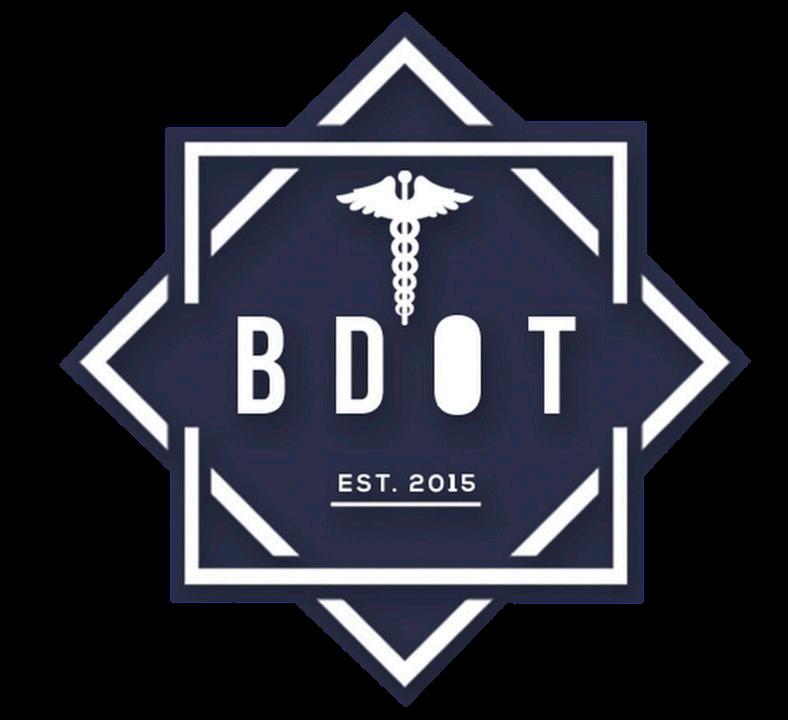
We, as students, have it hard enough and should not be the victims who sufer most from our housing crisis. For those of us who are working while studying, we have not been working for long and only have limited funds to secure housing. Moving into your own space for university should not be a luxury.
What if every UTM student could live on or near campus at an afordable price? This seems like a dream today — but it can be a reality with new resources now available to help students get ahead. The Government of Canada recently announced funding for new housing projects on and around university campuses, which could transform student housing options as we know it. I believe that this commitment could make a notable impact in solving the housing crisis if the university — and student representatives like the University of Toronto Mississauga Students’ Union (UTMSU) — seize this opportunity correctly.
As UTM students, we know that there are not a lot of places to call home on or near our campus — and when one becomes available, it is often unafordable anyway. Our housing situation is dire. Students and UTM’s administration have voiced concerns regarding UTM fulflling its commitment to housing all frst-years.
Thankfully, Ottawa is now ofering $40 billion in loans for postsecondary institutions, not-for-proft builders, and private home builders to build residences on or near campuses across the country.
While this is great news on the surface, it is not a guarantee that we will see substantial development. The Government of Canada is rightfully playing its part, but we need the involvement of others to make this vision successful. The UTMSU and UTM must seize this opportunity to maximize housing options for its students on its property. Doug Ford’s government is doing little to help right now, but they can incentivize home builders to partner with universities to “get it done” — his coined 2022 slogan — on campus or participate in the federal

government’s program near campuses.
I’ve worked in politics, and I’ve been very involved with UTM. Let me be frank: we, the students, must show our student union, the university administration, and the provincial government that we care about this issue and that we know they can play their part in addressing our afordability crisis. Until then, without pressure, we cannot expect anyone to act on this. The responsibility lies on us as students to make our leaders aware. We must push those who are responsible for improving our student experience to take action.
The UTMSU’s role in turning plans into homes
We as UTM students pay the UTMSU to be not only our voice on such matters but also to act as a safeguard to support our student body. The UTMSU has the resources to properly advocate for the things students care about. It can help students with the cost of keeping a roof over their heads as they pursue the right — not the privilege — of higher education. We have even seen other unions, like the UTSU, purchase property for students in urgent need. The UTMSU can engage with this new federal program, home builders, and the university to see more residence options for our students. The money is there to do it, and we know that because of the government’s recent announcement. With the UTMSU’s multiple millions of dollars in annual revenue, we know it should be able to afford to spend more on housing. I’ll acknowledge the UTMSU’s work with the Canadian Federation of Students to speak with the government on various issues including mental health, but we lack UTMspecifc advocacy directly to our leaders at all levels. Why have we let the situation get this bad?
Late last year, Jan Durkiewicz — a member of the UTM Campus Afairs Committee — and I spoke before the City of Mississauga’s Transit Committee, representing student concerns around
transit at UTM. We were there as students, acting outside of our scope of responsibility as members of UTM’s Campus Council and Campus Afairs Committee — even though the body most immediately responsible for transit is the UTMSU through the U-Pass program and its relationship with the city. Yet, despite two executives being present in the audience, the UTMSU did not speak. We did.
What I learned in that moment is, like in my experiences with politicians and government, unless we, the students, raise our voices and add accountability through the pressures of conversations, we cannot expect our leaders to fght for the things that can make substantive diferences in our lives. We can set a better standard for how the union operates, and we could actually see the UTMSU fulfll its mandate with this recent announcement from the federal government, but we have to, unfortunately, push our leaders to step up to the batting plate if we want to see home runs.
We must engage. We must raise our voices. We must have conversations for us to see change. So, I am encouraging you to do this. Post on social media and tag the UTMSU. Email the union. Visit its ofces. Let executives know that we know that the tools to address the housing crisis they claim to care about now exist, and the ball is in their court to start working on the issue.
Take our conversation to social media, and make it known that the UTMSU has an opportunity to change our lives. We can create afordable and available housing for UTM. Will you do your part to help ensure UTM students get their fair share of the $40 billion?
Ehab James is a third-year student at UTM studying political science and sociology. Ehab is a member of the UTM Campus Council, UTM Academic Afairs Committee, UTM Nominating Committee, and the UTM Academic Plan Task Force.
The Toronto Police Service’s treatment of pro-Palestine protesters is selective and oppressive December 10 protests revealed how the TPS specifcally criminalizes pro-Palestine protesters
Content warning: This article contains descriptions of violence and mentions Islamophobia and antisemitism.
One of the most powerful moments in Toronto’s pro-Palestine movement was when two separate protests merged at 52 Division Police Service last December.
On December 10, two pro-Palestine protests converged at 52 Division Police Service in downtown Toronto, resulting in thousands of individuals occupying Dundas Street West to demand the immediate release of a protester who was arrested. The individual was arrested for allegedly tackling a Toronto Police Service (TPS) ofcer during a proPalestine protest, but several individuals claim that the protester was defending a cyclist that TPS offcers pushed to the ground.
It is no surprise when police revert to reactionary and aggressive tactics in times of heightened confict. It is such moments that remind us of what I believe to be the truth: the TPS community policing mandate of attempting to create a partnership between police and the community is a false front behind which disparity continues to persist. In my view, the pro-Palestine protests reveal how the TPS continues to target minoritized groups and meet protesters with violence, ultimately working against the well-being of Toronto’s community.
Public Safety Canada defnes community policing as a philosophy that “support[s] the systematic use of partnerships and problem-solving techniques to proactively address the immediate conditions that give rise to public safety issues such as crime, social disorder, and fear of crime.” Deconstructed, community policing allows the public to play a role in addressing public safety
problems that the police may overlook. The TPS has attempted to implement community policing through initiatives such as the neighbourhood community ofcer program.
On paper, community policing is an active step toward improving police-citizen relations, but in practice, it is vulnerable in the face of disruptive citizen practices — including protests. We have yet to see the TPS implement applicable and reliable community policing practices, and I see this as a testament to the TPS’ failure to substantiate its community policing initiatives.
When contextualizing this failure at the proPalestine protests, it becomes clear to me that this community policing is selective. Pro-Palestine demonstrations were recently banned on the Avenue Road overpass and TPS Chief Myron Demkiw assured citizens that the police will be applying a “criminal lens” to protests in the city. How does criminalization ft into the proactive, problem-solving approach that was promised by the TPS’ community policing guidelines?
Repeated police mistreatment of protesters reveals an uncomfortable truth: the police do not always exist to serve and protect. Rather, the police organization often works in conjunction with oppressive systems by targeting, silencing, and punishing minoritized groups.
Does community policing truly apply to all Canadian communities? Does it apply when those who require protection and support are directly challenging the status quo? I interpret the TPS’ treatment of pro-Palestine protesters to be a direct and negative answer to these questions.
It is important to note that there has been a rise in Islamophobia and antisemitism since the October 7 attacks. Groups that are already vulnerable to hate-motivated attacks are now facing increased threats, and the police are crucial in denouncing hate-motivated attacks through criminalization and
arrest. Despite this precarious situation, peaceful protesters continue to be criminalized and proPalestinian messages are aligned with hate speech, reinforcing harmful ideologies that incite hate-fueled attacks to begin with.
Of course, both protests and protesters can become unruly, aggressive, and even violent at times. Despite this, I believe that TPS ofcers should not be regressive in their response. The ideological framework of community policing should extend into all areas of policing, especially in situations where the community is directly interacted and engaged with. Police training should emphasize de-escalation and crowd management, and community partnerships should be at the core of police response to protests.
To me, the December 10 protests were symbolic in demonstrating that contemporary police practices are oppressive in nature. The oppression of marginalized voices is rampant in our own communities. Acknowledging these lived realities and accepting the needs of diverse communities are crucial steps in crafting an appropriate and productive response to protest — unfortunately, this is a step that the TPS has yet to take.
Ayesha Firoz is a third-year student at Victoria College studying criminology and sociolegal studies and sociology. She is a Local Afairs columnist for The Varsity’s Comment section.
If you or someone you know has experienced harassment or discrimination based on race, ancestry, place of origin, colour, ethnic origin, citizenship and/or creed at U of T, report the incident to the Anti-Racism and Cultural Diversity ofce: https://antiracism.utoronto.ca/help/.
You can report incidents of anti-Muslim racism through the National Council of Canadian Muslims’ Hate Crime Reporting form at https:// www.nccm.ca/programs/incident-reportform/, and antisemitic incidents at U of T to Hillel U of T at https://hillelontario.org/uoft/ report-incident/.
If you or someone you know is in distress, you can call:
• Canada Suicide Prevention Service phone available 24/7 at 1-833-4564566
• Good 2 Talk Student Helpline at 1-866925-5454
• Connex Ontario Mental Health Helpline at 1-866-531-2600
• Gerstein Centre Crisis Line at 416-9295200
• U of T Health & Wellness Centre at 416978-8030


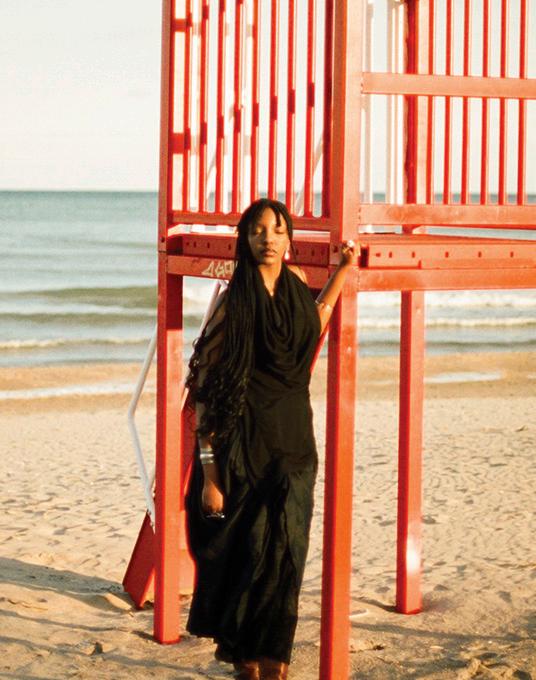
It all began with the click of a shutter. I was only 14 when I chose a brand-new Nikon D5300 over a PlayStation 4. Back then, everybody I knew had a gaming console, and in a bid to be diferent, I chose to get the camera. Besides, Instagram was all the rage back then, and I knew I could take the best pictures.
Fast forward a couple of years later, what started as the hunt for a cool photograph has since grown into a self-expressing art that seeks to resonate with the hearts of those who choose to look.
In my latest project, For All The Lessons Learned, I tackle the theme of vulnerability during self-refection. During the portrait sessions, I employed a unique approach: I triggered the shutter to take a picture 10 seconds after informing the model, Anais Shalita, to prepare for the photo. This extended pause allowed me to capture the candid moments where Anais was momentarily free from her meticulously crafted pose and soaking it all in.
In addition, we were shooting in negative 15 degrees Celsius, and since she hails from the beautiful country of Rwanda, she wasn’t accustomed to handling these harsh temperatures in nothing but a silk dress. This brought an unguarded authenticity to the images and resulted in a series of photos depicting the introspective moments after a performance and the inherent vulnerability that accompanies such moments of raw, unfltered self-awareness.
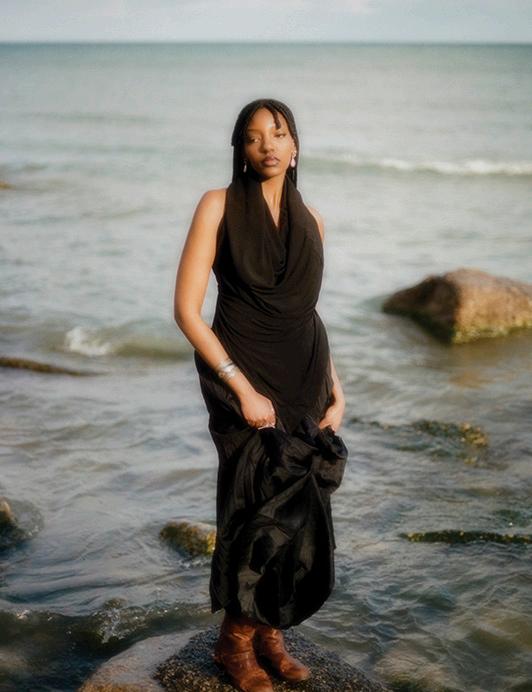
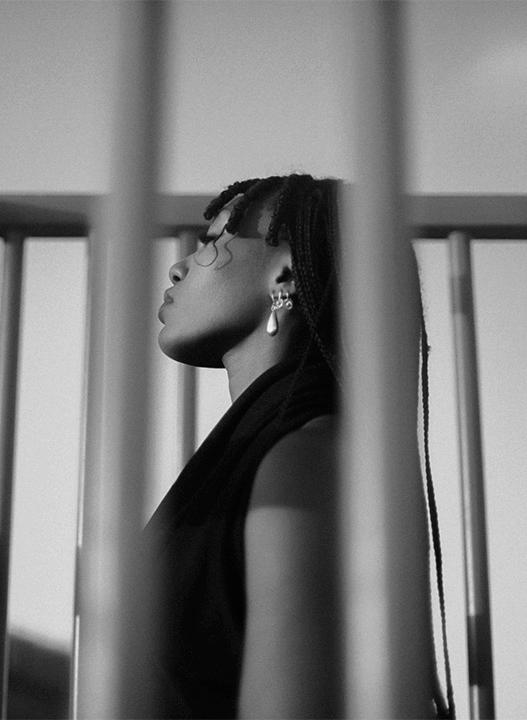
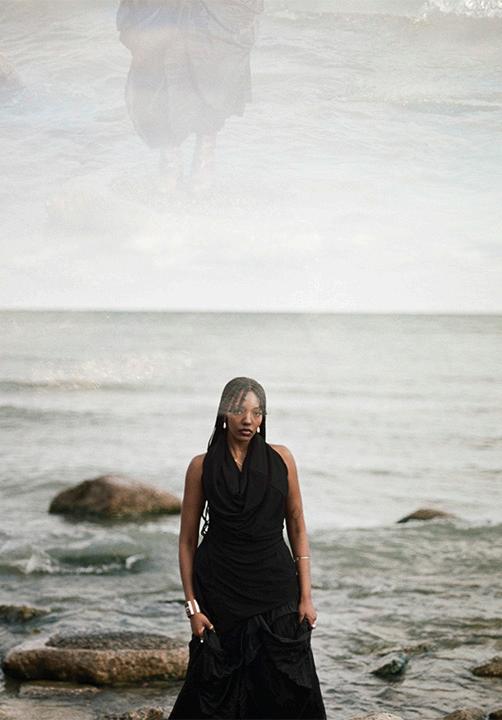


“Enough is enough,” say union presidentsThomas Law Labour Correspondent
Thousands of workers across all U of T campuses and three diferent chapters of the Canadian Union of Public Employees (CUPE) are threatening to go on strike if they do not reach a new deal with the university by March 4.
CUPE 3902 and 3261 workers gathered on the steps of Convocation Hall on February 8 to outline their grievances and demands, which broadly include increased pay and support, as well as better working conditions. CUPE 3902 President Eriks Bredovskis and 3261 President Luke Daccord wrote to The Varsity that these arguments boil down to “respect and dignity, and provid[ing] all workers with a living wage.”
More than 8,000 workers across seven bargaining units, covering all three U of T campuses, are represented by three CUPE trade unions. These units include 3902, representing contract academic workers like Teaching Assistants (TAs) and postdoctoral fellows; 3261, representing service workers such as caretakers; and 1230, representing library workers.
“Enough is enough… we all share one employer, one workplace, and one understanding that our work is fundamental to the university’s success. It cannot function without us,” explained Eriks Bredovskis, CUPE 3902 President to The Varsity in an email.
“There’s something going on when TAs, postdocs, caretakers, and food service workers all recognize that they are in the same struggle together,” said CUPE Ontario President Fred Hahn to CUPE members during the February 8 demonstration.
The demands
Bredovskis wrote that CUPE’s demands “all circle
back to wanting a workplace that treats us with respect and dignity, and provides all workers with a living wage.” This includes extending a living wage to the lowest paid workers in the three unions, which include workers classifed as “casual workers,” cafeteria workers, and postdoctoral fellows. These demands also include calling for an end to funding clawbacks that have eaten into education workers’ salaries.
A press release published by CUPE quoted Bredovskis saying that although his unit’s members do “the vast majority of teaching” at U of T, their pay does not refect this. Given their current income, some members “can’t even aford to live in the city they teach in,” Bredovskis said.
With Bill 124 — a 2019 bill that reduced public sector pay increases to a maximum of one per cent per year — having been ruled unconstitutional, the unions are demanding that the university accept proposed wage increases above the nowstricken-down limit. Unit 3261 demands a “living wage” of about $25 an hour for its workers — the minimum rate that the Living Wage Network calculates is necessary to cover the basic cost of living in the GTA. It is also $8.45 more per hour than Ontario’s minimum wage rate.
“We’ve asked them to pay our members a living wage of $25 an hour and they told us at the table that they can’t aford it despite a net income of more than half a billion dollars last year,” Daccord asserted in a speech at the February 8 demonstration.
It is not just as simple as more pay, however. Bredovskis wrote to The Varsity that during negotiation talks, the union has not been satisfed with the university’s ofers for healthcare coverage, and the university will not agree to subsidize workers’ public transit costs, which the CUPE press release states is common for CUPE units in other
Professor Radha Maharaj teaches fnancial literacy to combat racial wealth gaps
Workshop series aims to help BIPOC students manage fnances, tackle barriers
 Georgia
Georgia
Here are two of the issues that Radha Maharaj, a fnance professor at UTM, aims to tackle in her “Wealth Building” workshops, which are specifcally designed for Black, Indigenous, and people of colour (BIPOC) students: U of T students’ very poor average fnancial literacy, and the persisting wealth gap between BIPOC and white people in Canada.
The workshop is hosted by the Hart House Black Futures program, which runs a variety of workshops, panel discussions, and events to create spaces specifcally for the Black U of T community.
Maharaj has been running fnancial literacy workshops both within and outside U of T for a decade. Her latest series of workshops — which ran between January and February of this year —
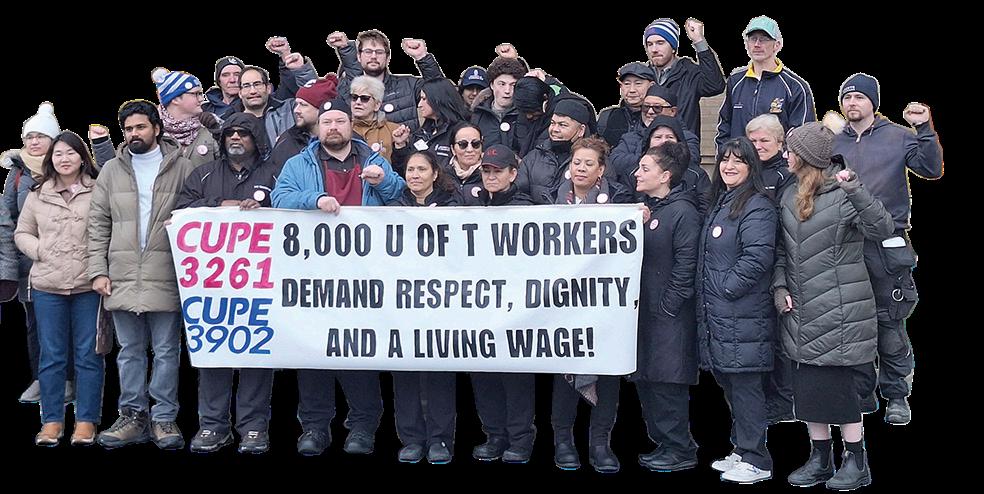
universities in Ontario. Bredovskis wrote that the university has justifed this decision because workers “choose where [they] live.”
Will they walk out?
CUPE 3902 Unit 1, representing TAs and course instructors, served U of T with a notice to bargain on October 26, 2023, indicating their intentions to bargain for a new collective agreement, in advance of their previous agreement’s expiration on December 31, 2023. Despite provincial statutory obligations to meet within two weeks of such notice, the frst round of talks did not take place until 82 days later, on January 15. Even then, Bredovskis wrote to The Varsity that “the university has not matched [the union’s] energy, preparedness, or sense of urgency” in talks.
So, where to next? Earlier this month, CUPE 3902 leadership put strike mandate votes to its members, in efect asking them for an endorsement to call a strike should current talks fail to produce a deal that members agree to. Unit 1 and 5 members voted overwhelmingly in favour, delivering 94.4 and 95.1 per cent mandates respectively.
Voting began for CUPE 3261 members on February 18, and closed on February 22.
Units 3261 and 3902 requested and received a notice from the Ontario Ministry of Labour that granted them the legal capacity to begin a 17-day countdown, starting February 16, toward a legal strike action.
That means that if U of T and the union do not agree to a satisfactory deal by March 4, both

“68 per cent of the respondents received a grade [between] D- to D+,” Maharaj recounted. Yet, despite these abysmally low scores, respondents were still very optimistic about their personal level of fnancial literacy. Moreover, many participants responded that they felt they did not need to worry about managing their personal fnances until they started earning higher incomes, something that Maharaj disputes. This survey is part of her inspiration for running the Hart House series.
One of the frst things that Maharaj taught workshop participants, she wrote, is “[the] fundamental distinction between self-worth and net worth.” This lesson in itself is fnancial advice, Maharaj asserted, noting that confating the two tends to cause individuals more anxiety and stress, and even a “keeping up with the Jones” mindset of social comparison, which ends up making individuals worse problem solvers and irresponsible spenders.
unions will be in a legal strike or ‘lockout’ position. The strike votes and the reports do not automatically trigger a strike — rather, they empower unit leaders to call for various labour disruptions, up to and including a strike.
Before that point, there is still time to come to an understanding. CUPE 3902 Unit 1 has scheduled talks with the university for February 20, 21, 28, and 29. CUPE 3261 also has negotiations scheduled for February 22 and 23, and March 1. CUPE 1230 has dates at the table for February 27 and March 1.
The nature of industrial action is disruptive to staf, institutions, and the people using their services alike. Daccord and Bredovskis wrote that it is a last resort: “a strike will only be called if U of T fails to meet our demands for critical economic and structural support that will help all our members provide the world-class experience all students deserve.”
The university declined to address The Varsity’s enquiries regarding CUPE leadership’s specifc allegations and demands, since units 3261 and 3902 are currently undergoing collective bargaining. “The parties have worked together successfully in many previous rounds of bargaining to negotiate renewal collective agreements without labour disruptions,” a spokesperson wrote to The Varsity in an email.
“The university looks forward to ongoing constructive and productive discussions with these CUPE locals towards tentative agreements that address the needs of the workers and the university,” they wrote.
people. A 2019 report from the Canadian Centre for Policy Alternatives, drawing on 2016 census data, found that racialized people in Canada are more likely to be unemployed, to be born into a family in the bottom half of Canada’s income distribution, and to make a lower income on average compared to white people in Canada.
The report also found that Black workers in Canada in particular are more likely to be unemployed and experience higher wage gaps than the average rates among all racialized groups.
Maharaj pointed to a 2021 census from Statistics Canada, which found that individuals who identify as part of a visible minority — a term that the organization defnes as covering racialized people who are not Indigenous — had poverty rates of 9.5 per cent, while individuals who do not identify as part of a visible minority had poverty rates of 6.5 per cent.
is the third iteration of her wealth-building workshop series at Hart House, specifcally for BIPOC students.
The wealth-building workshops include typical personal fnance lessons such as creating emergency funds, limiting excess spending, managing debt, and investing. In the latest series, Maharaj had participants use a “crypto investing simulator” to familiarize themselves with investing in cryptocurrency and understand how the volatility of markets may impact their personal fnancial goals.
In emails to The Varsity, Maharaj emphasized that she has designed the workshops to encourage students to voice their own opinions and questions — including criticisms of the current fnancial system’s accessibility and queries about existing fnancial inequalities.
In 2019, Maharaj ran a survey with 574 UTM students to test their average level of fnancial literacy.
The distinction is especially important for BIPOC students to internalize, Maharaj described, since manifestations of racism from systemic oppression to everyday microaggressions can be very damaging to their individual self-perception. “As a female member of the BIPOC community myself, I can relate to the lived experience of many of the students who attend these workshops,” Maharaj wrote.
Tackling systemic inequalities
Economic inequality between BIPOC and white people in Canada is not a straightforward issue to understand — diferent racialized groups have diferent economic demographics and are afected by difering histories of migration and oppression in Canada. Intersectional factors such as gender and immigration status also play a role in wealth.
However, there are clear general patterns in economic inequality between BIPOC and white
Canada’s persisting racial wealth gap, she noted, is the result of “historical and systemic inequalities” in access to education, employment, and entrepreneurship.
This is why Maharaj underscores the importance of BIPOC students increasing their capacity to earn money and strengthening their money management skills. She described that efective fnancial skills can give an individual better chances of getting hired, completing college or university, and starting their own businesses. Maharaj also noted that these skills help students avoid being taken advantage of by fnancial professionals and institutions like lending services, who are liable to deliberately confuse clients whose fnancial literacy skills are poor.
Maharaj noted that these opportunities can serve to build BIPOC communities’ generational wealth — money and assets that families pass down to the next generation — allowing them to have better fnancial health and increased access to opportunities.
 Ridhi Balani Science Correspondent
Ridhi Balani Science Correspondent
Ever gotten lost in the wilds of Toronto, given up on the cardinal directions, and fnally pulled up Google Maps?
Having the option to follow GPS directions blindly is a result of decades of mathematical computations — and much of the credit should go to icon and mathematician Gladys West.
But frst, how does a GPS work exactly?
The basics of GPS
The Global Positioning System (GPS) is an integral part of everyday life, from fguring out the location of obscure campus buildings to mapping and tracking natural disasters. However, in the 1970s and ’80s, the implementation of GPS had two mathematical challenges: time dilation and trilateration.
Time dilation is a phenomenon based on Albert Einstein’s theory of relativity, where time passes diferently for diferent observers based on their motion and the force of gravity they experience. Essentially, the faster the motion of an object, the slower time moves for it. Additionally, the stronger the gravitational force an object experiences, the slower time moves for it.
The high speeds of GPS satellites result in time being delayed by seven microseconds per 24 hours for the satellites. However, the satellite is also far away from the surface of the Earth, which lowers the gravitational force it experiences, resulting in time ticking faster by around 45 microseconds per 24 hours.
Overall, time is sped up by around 38 microseconds per 24 hours for GPS satellites. While this may not seem like a lot, such a small time dilation can cause errors in calculation that lead to
inaccuracies, with locations incorrect by metres and even kilometres. Thus, GPS calculations have to account for this time dilation.
The second challenge of GPS is trilateration. Trilateration is a mathematical technique for
tersection points. A third satellite narrows the intersection to two points, providing a very accurate account of receiver location, but does not necessarily provide details of elevation. Our modern system adds a fourth satellite to the mix to add data about

accurately determining a receiver’s position, speed, and elevation, using a combination of signals from satellites orbiting the Earth at speeds of around 14,000 kilometres per hour.
A receiver — a common component of the GPS found in all phones today, among other devices — needs at least three satellites to determine its location accurately. A singular satellite only tells the distance between itself and a receiver, which creates a sphere of possible locations where a receiver could be. Another satellite creates another sphere of possible locations. Where these two spheres merge, the location narrows down to a circular area of in-
My journey to cardiac surgery as a Black medical student
receiver elevation by determining the fnal, correct point of intersection between all four satellites. Currently, there are around 30 satellites that provide GPS data. However, a major obstacle in determining the accurate distance measurements that GPS is based on is the actual shape of the Earth. This is where the key contributions of Gladys West come into play.
The shape of the Earth
Contrary to typical models of the Earth, it isn’t a true sphere. The centrifugal force, or the force the Earth’s rotation exerts on it, causes the Earth to

On the scarcity of Black students and mentors in the feld, and signifcant milestones in my career
Ekene Nwajei
Varsity Contributor
My journey has been characterized by signifcant milestones, both academically and professionally.
In 2022, I graduated from Health Sciences at Wilfrid Laurier University with high distinction, which solidifed the foundation for my pursuit of medicine. In the same year, I joined U of T’s medical school, marking the beginning of a transformative chapter where I am seeking to not only excel academically but also pave the way for future Black students interested in medicine.
My journey into the world of cardiac surgery has been fuelled by a profound passion that took root during various moments in my life. During my frst month as a student in the Temerty Faculty of Medicine, under the guidance of Dr. David Latter — a cardiac surgeon at St. Michael’s Hospital — I had the privilege of encountering my frst surgical experience: a cardiac operation.
During the operation, the profound impact of life-saving cardiac surgeries in enhancing a patient’s quality of life became strikingly evident. From witnessing the transformative impact of cardiac surgeries on patients to the intricate dance of precision in the operating room, I discovered a calling that resonated with my deepest aspirations.
The summer of 2023 marked another turning point in my medical education. That summer, the cardiac surgery division at St. Michael’s Hospital awarded me the Edwards Life Sciences & Temerty Faculty of Medicine & St. Michael’s Hospital Black and Indigenous Cardiac Surgery Research Summer Scholarship. This scholarship is awarded
to support students who are interested in cardiac surgery.
The scholarship provided me with a unique opportunity to immerse myself in groundbreaking research alongside Dr. Subodh Verma, a distinguished cardiac surgeon. Working alongside Dr. Verma crystallized my understanding of the profound impact cardiac surgery could have on individual lives and intensifed my commitment to becoming a cardiac surgeon. Exploring innovative approaches toward cardiac surgery and gaining insights into the intricacies of the feld strengthened my resolve to contribute to this transformative feld.
As a Black medical student aspiring to break into the traditionally underrepresented feld of cardiac surgery, challenges have been an inherent part of my journey. Navigating a path that lacks role models requires resilience and determination. Thankfully, the Division of Cardiac Surgery at U of T has provided me with mentors who have both helped me develop professionally and personally.
That said, the journey to cardiac surgery is marked by rigorous academic demands and intense competition. As a Black student, I have faced additional challenges in navigating a feld where achieving diversity remains an uphill battle. However, each challenge became an opportunity to defy expectations and contribute to endeavours toward inclusivity within the medical community. Each challenge became an opportunity to show that it is possible to contribute to the feld of medicine, despite the lack of diversity. And in the future, I hope to change the feld to include more diversity, as a cardiac surgeon.
fatten at the poles and bulge at the equator, resulting in an ellipsoid or a slightly squashed sphere. However, the Earth isn’t even a perfect ellipsoid. It has a complex topography resulting from the vast oceans, mountains, valleys, and other geographical features that afect elevation.
Because of this deformed ellipsoid shape, it’s difcult to tell how far a satellite is from a specifc place on the Earth’s surface. The surface even changes daily due to fuctuations in the ocean levels due to tides. These factors make it difcult to model the shape of the Earth.
Gladys West, a Black woman mathematician, was up for the challenge. Throughout the 1970s and 1980s, she developed a program that mathematically modelled the complex shape of the Earth accurately as an ellipsoid with difering surface elevations, called the geoid. West wrote the guide to getting precise measurements of a satellite’s position relative to Earth. Because GPS is based on these precise measurements, it would be impossible to have accurate GPS systems without West’s contributions.
In 2018, West was inducted into the Air Force Space and Missile Pioneers Hall of Fame for her contributions to the development of GPS. While she was recognized for her part in the development of GPS, it is disappointing that this recognition came so long after the induction of three other inventors of the GPS in 2004. Despite the delayed acknowledgment of her achievements, West stands as an inspiration for racialized women pursuing careers in physics.
So, the next time you rely on GPS for directions, remember the extraordinary mathematical career of Gladys West, the icon behind the navigation technology we often take for granted.
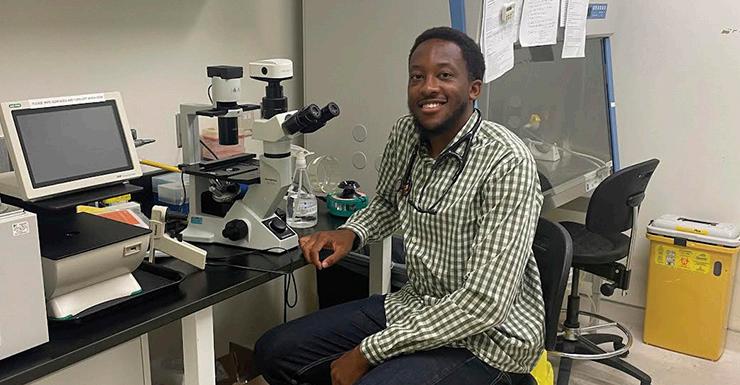
In 2022, Dr. Bobby Yanagawa, U of T’s head of the Division of Cardiac Surgery and program director, created the Next Surgeon Program to inspire high school students from Toronto Community Housing to consider a career in medicine. I have had the great honour of contributing to this program by being a mentor to an enthusiastic group of children. As a mentor, I delivered talks, taught basic surgical skills, and built genuine relationships with some of the youth.
Inspiring others to take a challenging path despite a lack of representation is a goal that I would like to keep at the forefront of my endeavours as I continue my journey through medicine. In doing so, I hope to also motivate others to break barriers.
The milestones in my journey to becoming a cardiac surgeon are not only personal triumphs but also represent a broader narrative of breaking barriers in the feld of medicine. Each accomplishment contributes to reshaping the landscape of medicine, striving for inclusivity, and fostering an environment where diversity is celebrated.
The recognition bestowed upon me by the Edwards Lifesciences Scholarship and then later The Society of Thoracic Surgeons (STS) Looking To The Future Scholarship have been instrumental in propelling my journey forward.
These scholarships have not only provided fnancial support but have also served as powerful afrmations of my dedication to cardiac surgery.
The Edwards Lifesciences scholarship, and the immersive research experience that working with Dr. Verma has provided me, deepened my understanding of the potential to transform patients’ lives by applying my medical knowledge acquired through school and research endeavours.
Winning the STS scholarship not only validated my aspirations but also opened doors to invaluable networking opportunities and connections within the cardiac surgery community. This scholarship allowed me to connect with cardiac surgeons from all over the world, gave me a chance to meet them in person, and created a great opportunity to share my passion and interest in such an exciting specialty. This further motivated me to continue going down this long but rewarding career path.
My journey to cardiac surgery is more than a personal narrative. It is a testament to the resilience, determination, and passion that drive individuals to overcome challenges and break down barriers. As I navigate a path toward becoming a Black cardiac surgeon in Canada, I hope my story inspires future generations and contributes to a more inclusive and diverse landscape within the medical profession.
Canada’s public health system is not equal for all


rates of risk for diseases such as heart disease and stroke. Finally, the 2021 study found that racialized groups were six to seven times more susceptible to COVID-19, further cementing the need for improved access to healthcare in marginalized communities.
The ethos of Canada’s healthcare system relies on principles of equality and diversity. Healthcare providers have a duty to provide unbiased treatment and care to all patients regardless of their race, gender, class, or socioeconomic status.
However, Canada — the land of free healthcare and multiculturalism — fnds itself confronting a stark reality. Multiple studies have illuminated longtime, deeply-rooted systemic biases within its public health system that particularly impact Black Canadian communities. The fndings of these studies are crucial to our understanding of the intersection of healthcare access, racial equity, and social justice, and are essential to the path of healthcare reform.
Black Canadians face a range of obstacles in seeking care
A 2021 study published in the International Journal for Equity in Health worked with members of racialized communities in Toronto and grouped their negative experiences in the health care system into fve clusters: dehumanization, negligent communication, professional misconduct, racial
and class discrimination, and unequal access to healthcare resources and treatment.
Dehumanization as a patient was a common experience among participants, as well as having unequal access to care. Such disparities not only compromise the health outcomes of Black patients but also erode trust in the healthcare system, discouraging racialized groups from seeking care and perpetuating cycles of poor health.
Despite being the third-largest racialized group in Canada, Black Canadians face a myriad of obstacles with respect to accessing social support systems and health services, such as social and economic barriers. A 2023 literature review published in The National Library of Medicine noted that many Black Canadians indicated that they would prefer to seek out mental health resources provided by Black healthcare workers.
The data emphasized the need for a stronger focus on the integration and support of Black healthcare providers to promote access and inclusivity for patients seeking treatment.
The review also found that the everyday racism experienced by racialized groups had a strong correlation to the exacerbation of negative health outcomes and higher levels of mental illness, such as depression. Black Canadians also face higher
The long history of Black women’s exploitation in medical and domestic contexts
Historically, Black Canadians have been exposed to prolonged trauma as a result of colonialism, racism, and segregation, which has led to them being underprivileged and having reduced access to healthcare services. Other social determinants that further exacerbate healthcare disparities include hindered access to education, afordable housing, mental health supports, and equitable employment opportunities. Improving access to healthcare begins with acknowledging these determinants and developing more inclusive strategies to target them.
Implicit biases, unconscious attitudes, and stereotypes harboured by healthcare providers and researchers also play a detrimental role in perpetuating disparities in care delivery. For example, if a physician has an unconscious belief that a patient is inferior to them, they may minimize the patient’s symptoms or concerns. This can lead to a less thorough screening, which results in a poorer quality of care for the patient, as well as negative feelings toward the physician.
Moving forward, more studies need to be conducted on Black Canadians and their experiences with healthcare. Canada has historically left Black Canadians out of the narrative by not collecting data from this population for databases, health registries, and other healthcare settings, which has led to a reliance on proxies for information on marginalized groups. These proxies include immigrant status and region of origin, both poor classifers for any studies that intend to use racial data. This has further contributed to the rapidly widening gap in accessible healthcare.

How medical experiments have violated Black women and how scientists constructed racial diferences to justify enslavementNazareth Tsegay
Content warning: This article describes violations of the bodily autonomy of Black women, and contains graphic descriptions of racism and physical and sexual violence.
In May of 1962, Malcolm X, a prominent civil rights leader, pointed out during a speech that Black women were both the most disrespected and unprotected people in America. The poor treatment of Black women is especially evident in the medical and domestic spheres. As exemplifed by the case of Henrietta Lacks, Black women have been forced to take part in brutal trials and unethical experiments in the name of medicine.
J. Marion Sims’ standardization of a procedure for vesicovaginal fstula on Black women is another prominent example of this pattern. Documented cases of the prioritization of enslaved women’s reproductive capabilities over their wellbeing and race-based constructs about physiological diferences between Black and white populations further illustrate how Black women’s bodies have been violated because of discrimination in science. Acknowledging this history is important in resisting the existing systemic traces of the racism that led to these historical injustices, which still oppress Black women today.
The case of J. Marion Sims and the vesicovaginal fstula procedure
J. Marion Sims, an American surgeon, is considered to be the father of gynecology for his work in standardizing the surgical procedure for vesicovaginal fstulas, a condition in which an opening forms between the vaginal walls and the bladder.
The process of standardizing this procedure began in June of 1845, which is when he frst encountered cases of vesicovaginal fstula. Sims performed numerous surgical trials of the procedure on enslaved Black women. Sims considered the process of standardizing the procedure for vesicovaginal fstula experimental, so he was uncaring about the outcomes of the Black women on which he experimented. Their fates during the surgery were not important to Sims.
Despite the availability of anaesthetics at the time, Sims did not use them while performing surgical trials on enslaved Black women. He only began using anaesthetics on his white patients after his success in standardizing the procedure — when he cared to recognize that white women who came to him could not handle the pain of the procedure while conscious.
Sims’ choice to not use anaesthetics emphasizes his disregard for the pain and humiliation of Black patients during surgery. The enslaved women sufering from vesicovaginal fstulas could not perform feld work or household duties, nor could they have children due to complications of the condition, so Sims’ choice to perform experimental procedures on these women was nothing more than a way for their enslavers to gain some form of value from their enslavement of these women.
In one case, 12 physicians observed the procedure Sims enacted on a Black woman called Lucy, in her most vulnerable state as she endured this painful surgery without anaesthesia, positioned on her hands and knees.
Slave owners capitalizing on enslaved women’s fertility
The state’s prioritization of Black women’s bodies over their well-being is another form of dehumanization that Black women have faced.
Policy and reform for health equity
The fndings from these studies have profound implications for healthcare reform and policy. The frst step toward change begins with healthcare professionals’ awareness of systemic barriers within our healthcare system, which can then be used to develop equity-driven strategies to encourage inclusivity and accessibility for marginalized communities in healthcare practices. Anti-racism strategies are also essential to respond efectively to the oppression and inequitable treatment of Black Canadians by the healthcare system.
Recruiting and retaining a diverse workforce that refects the racial, ethnic, and cultural diversity of Canada can enhance cultural competence, foster trust and rapport with patients, and improve the quality of care delivered to Black communities. Moreover, creating pathways for career advancement and leadership opportunities for underrepresented minority healthcare professionals can help address disparities in healthcare leadership, ensuring that the perspectives and experiences of Black Canadians are adequately refected in healthcare policy and practice.
Both the 2021 study and the 2023 literature review also discussed how collaboration between healthcare providers, agencies, community organizations, and the government are crucial to implementing trauma-informed practices that are accessible to Black patients and patients from other racialized groups. Trauma-informed care involves acknowledging an individual’s full history and trauma-based responses when providing care. Encouraging culturally-sensitive training and enhancing diversity in our healthcare spaces are imperative when it comes to healthcare reform.
In our journey toward health equity, addressing the systemic bias within Canada’s public health system is a fundamental obligation rooted in social principles and human rights. By refecting on the insights extracted from these studies and embracing a commitment to transformative action, Canada can strive toward a future where healthcare is truly accessible, inclusive, and equitable for all.
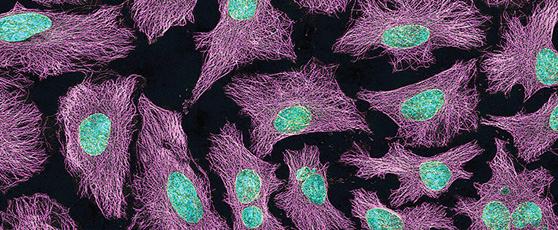
The prioritization of enslaved women’s fetuses over their own lives has played a role in court decisions and emphasized the notion that a Black woman’s value is rooted in her fertility.
An 1855 court case involving the state of Missouri and an enslaved 14-year-old girl regarding the murder of an enslaver highlights this sentiment. The Black girl, named Celia, had been the victim of multiple rapes by her enslaver and was forced to have two children as a result. Celia retaliated against her enslaver and murdered him, which led the state to press murder charges against her and eventually fnd her guilty of the act, disregarding the brutal acts to which he subjected her.
The court sentenced the young woman to death, but during the trial, she was pregnant with a child from the sexual abuse she had endured. Because of this, the state decided to keep her alive until she gave birth to the child; only after the event would she be subject to capital punishment.
Constructed myths about racial diferences to justify enslavement
Enslaved women were often the victims of dehumanizing punishments that slave owners justifed on the basis of constructed biological diferences between Black people and their white counterparts.
During the nineteenth century, scientists made comparisons between Black people and animals such as apes and went as far as to say that apes would be able to breed with Black women, which led to the idea that Black people are physically stronger than white people. The enslaver who chose to believe this punished enslaved women more severely on the grounds that they would be able to handle the pain due to their biology.
One documented account of an enslaved woman whose enslaver struck her on the head with a piece of wood highlights a case of the latter’s choice to believe in race-based biological diferences. The woman described the shock and surprise expressed by her enslaver when she lost consciousness. Another account of brutal mistreatment includes an enslaver forcing a woman he’d enslaved to eat food that was fatal to his dog because the owner had believed that the woman’s stomach was stronger than the dog’s. These accounts highlight how race-based biological diferences were constructed, as ‘real’ science, to justify enslaving and punishing Black people.
Racist ideologies during the nineteenth century dictated how white people treated enslaved African American women, in both medical and domestic settings. The case of standardizing the surgical procedure for vesicovaginal fstula is but one example of the involuntary contributions of enslaved Black women to advance the study of medicine. The case of Celia and others like her illustrate the extent to which Black women’s bodies have been further violated even in non-medical contexts. The constructed race-based biological diferences about Black people actually regressed medicine and helped enslavers justify subjecting enslaved African American women to gruesome and dehumanizing acts.
Unfortunately, some racial biases still hold a place in our world today. Many advancements in medicine, no matter how much scientists and physicians present them as objective and apolitical, are rooted in dark, racist, and dehumanizing histories. It is important, then, that we question the roots of common medical practices and that we push for more inclusivity in the medical feld going forward.
Centuries of racism and colourism have perpetuated a view that white skin is the beauty standard. Today, these racist ideals persist throughout the beauty industry. It’s no surprise then that the skincare industry falls woefully short in having diversity in marketing, understanding the concerns of darker skin tones, and meeting the needs of Black consumers.
Beyond the beauty industry, white skin persists as the standard for study and treatment in the field of dermatology. As a consequence, the medical community has a record of neglecting darker skin tones in dermatologic research and medical training. This lack of inclusivity in research and training has left doctors unprepared to address the skin concerns of Black patients.
How skin conditions affect darker skin tones
Melanin is a pigment in the human body that gives rise to skin, hair, and eye colour. Variations in skin colour are determined by the amount and distribution of eumelanin, a type of melanin found in the epidermis, the outermost layer of skin. While tanning can temporarily increase the quantity of eumelanin in
hyperpigmentation can affect anyone, it occurs more often and more severely in people with darker skin.
Despite the fact that darker skin has specific needs, the skincare industry is failing to put products on the shelves that cater to these needs. In a 2020 article for Well+Good, a digital publication dedicated to reporting on wellness, Miami-based board-certified dermatologist Heather Woolery-Lloyd said that over-the-counter products meant to reduce hyperpigmentation do not work as effectively for people with Black skin because they are designed for and tested on Caucasian skin.
For instance, arbutin is a key skincare ingredient that targets hyperpigmentation by inhibiting tyrosinase, an enzyme involved in melanin production. A 2005 clinical study by researchers at the University of Cincinnati found that unlike in white-skinned patients, arbutin only slightly reduced hyperpigmentation in dark-skinned patients. The researchers suggested that darker skin might require prolonged treatment or higher concentrations of arbutin to effectively inhibit tyrosinase.
Like the skincare industry, the medical community has also failed to treat the skincare concerns of people with darker skin.
A 2016 study by Sean M. Dawes and colleagues found that although cutaneous melanoma — a type of skin cancer — occurs more often in white individuals, non-white patients are significantly less likely to survive the condition. Numerous medical doctors and researchers have attributed this observation to the fact that physicians are not trained to recognize skin cancer in people with darker skin, so the cancer often goes untreated until




The racial disparities that are clearly visible in the skincare industry and the poor treatment outcomes for Black people can be traced back to one fact: Black people are largely underrepresented in medicine and medical research.
In 2020, despite Black people making up 6.4 per cent of Canada’s population, only 1.7 per cent of medical students identifed as Black, according to a study published in the Canadian Medical Education Journal. As of 2020, dermatology is also the second least diverse medical specialty in the US.
A 2021 study by researchers at U of T found that not only was there a lack of representation of skin of colour in the U of T undergraduate medical education curriculum but also U of T medical students were signifcantly more confdent in diagnosing dermatologic conditions in white skin compared to skin of colour. In a 2022 review, researchers at the University of Miami found that in more than half dermatology studies conducted in the US from 2010 to 2020, less than 20 per cent of participants identifed as non-white.
With the lack of diversity in dermatologic research, it’s not hard to see why both the skincare industry and the medical community’s understanding of dermatology is skewed toward white skin.
In a 2020 thread on X — formerly Twitter

Black business owners address the needs of their communities
The beauty industry and medical community have a track record of underrepresenting Black people, even when it comes to skin. However, in the past few decades, the beauty industry has seen a rise in Black business owners creating skincare lines specifically designed to meet the needs of people with darker skin.
One such business owner is Olomide Olowe, co-founder of Topicals, a sciencebacked skincare brand designed to work on dark spots, hyperpigmentation, and eczemaprone skin of all types. Last year, in an interview with Vogue, Olowe credited her own struggles with her skin and the lack of medical attention given to darker skin as motivation for founding Topicals. In an interview with Glossy, a media brand exploring changes affecting beauty, fashion, and wellness, Olowe also credited Black skincare communities on Twitter with changing the world of skincare by setting many of the trends that are popular today.
It’s not hard to see that both the skincare industry and the field of dermatology are systems built entirely around white skin. However, Black business owners and influencers in the skincare industry have started calling attention to the needs of people with darker skin to ensure that they feel represented in skincare marketing; to ensure that the skin -
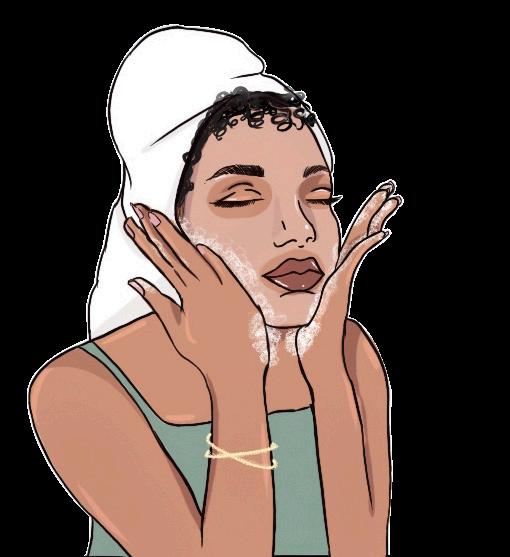







On an energetic night at the Goldring Centre, the Varsity Blues men’s basketball team defeated the Ontario Tech Ridgebacks 59–54 on February 24. As a result of their victory, the Blues have advanced to the Ontario University Athletics (OUA) semifnals for the frst time since the 1996–1997 season.
Because the Blues fnished at the top of the OUA central division with a 14–8 record, they were able to host a playof men’s basketball game for the frst time since the 2016–2017 season.
“Just playing at home [whether] it’s playofs or not… our guys [always] look forward to it, just because we get so many fans [and] so much support,” head coach Madhav Trivedi told The Varsity in a post-game interview.
Meanwhile, the Ridgebacks have had a historic “Cinderella” season, having qualifed for the playofs for the frst time in the history of their basketball program. Yet, the Blues weren’t going to underestimate them. “[They’re] in the playofs [for the] frst time, but they’re [still] a top 10 team,” Trivedi said.
Overall, the quarterfnal game was tight, with both teams battling back and forth — though ultimately, the Blues emerged victorious.
What happened
While the Ridgebacks got the frst bucket of the game — a three from guard Levi Ogbonna — the Blues were the team that came out of the
gates swinging, as guard Callum Baker scored the Blues’ frst six points of the game. Notably, Baker led the OUA in points per game and total points during the regular season. His step-back three-pointer would soon give the Blues an early six-point lead, and despite some pushback, the Blues maintained their lead until the end of the quarter, ending 23–16.
When the game resumed, both teams were locked in defensively. Nevertheless, guard Nadav Sahar nailed a three-pointer to get the Blues’ frst points of the second quarter, and the Blues’ ofense started clicking. Forward Somachi Agbapu bounced the ball into a driving Baker who easily laid the ball in for two points.
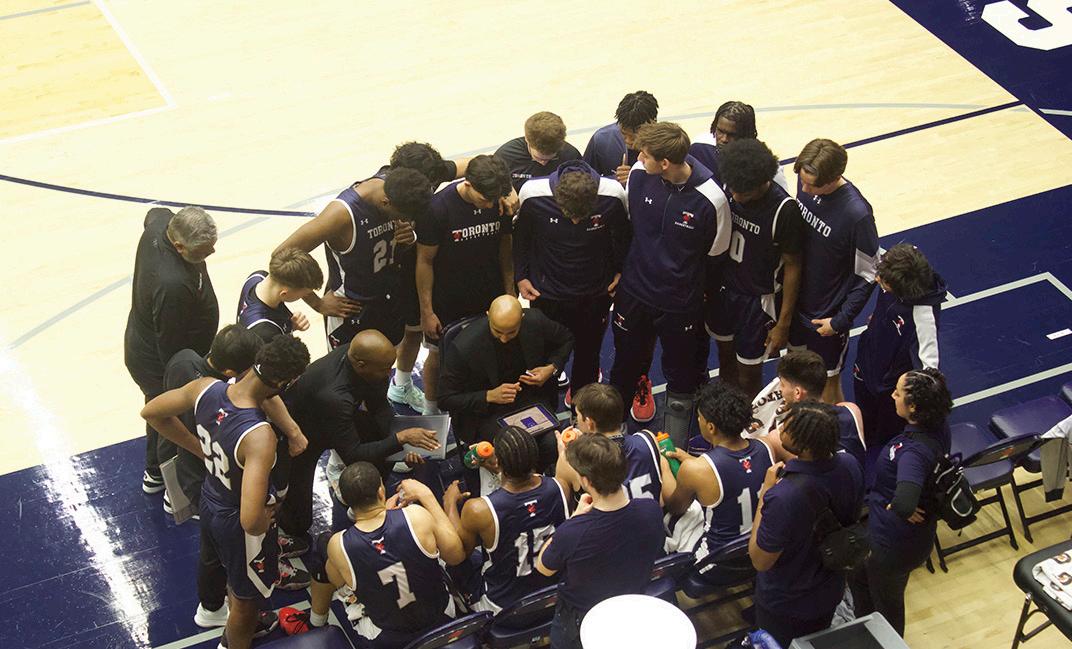
Immediately on the other end, Agbapu had a monster block, leading to a layup from sophomore guard Noah Ngamba. Sahar drilled a twopoint jumper and forward Anthony Daudu drove to the basket to increase the lead further.
The Blues maintained their lead, and as their lockdown defense forced a turnover from the Ridgebacks, the Blues ended the frst half on a high, with the score at 38–29 in their favour.
Yet, the Ridgebacks tightened their defense to start the second half, and the Blues’ ofense, which was thriving in the frst half, was now struggling. The Ridgebacks began chipping away at the Blues’ lead, scoring six unanswered points, and the Ridgebacks soon tied the game at 39–39. While big blocks from Ngamba and Agbapu kept the game level, the Ridgebacks would
The 2023 edition of Africa’s biennial continental soccer tournament — the Africa Cup of Nations (AFCON) — was hosted this January and February in Côte d’Ivoire. This was the second time in the country’s history it had hosted the tournament, having previously hosted it nearly 40 years ago in 1984.
The Ivorians have lifted the cup twice since their independence in 1960, with their most recent victory being in 2015, during what many consider to be the team’s golden era. This era included the likes of Yaya Touré, arguably the best African midfelder of all time. But, since then, the team has sunk, failing to go far in subsequent AFCONs as well as missing out on World Cup qualifcation twice in a row.
Though they lack former world-class players such as the Touré brothers and Didier Drogba, the Ivorians entered the current tournament with a balanced team in regard to the calibre of players they can feld on the defense, midfeld, and attack. The team includes the likes of Bayer Leverkusen centre-back Odilon Kossounou, whose team currently sits top of the Bundesliga; Franck Kessié, a versatile box-to-box midfelder who has won domestic titles with Barcelona and AC Milan; or even up-and-coming Premier League winger Simon Adingra, whose played a key role in maintaining Brighton & Hove Albion’s hopes of playing European soccer next season.
All this to say, I think most expected the Ivorian team to come out of their opening game victorious — and they did. The team was elated to have won since, regardless of their results in their next two matches, their three points from this game would most likely be enough to qualify for the next round — the four best-ranked

third-place teams in the six groups would directly qualify for the round of 16.
Unbeknownst to all of us who watched AFCON, fans saw a prequel to the eventual fnal, when Côte d’Ivoire’s next group-stage match was against the three-time AFCON-winning Nigerian team. As a Nigerian myself, I had similar expectations for both countries — a quarter-fnal fnish. I felt there were a lot of parallels between both sides. Nigeria’s last AFCON triumph was around a decade ago, our golden era was well past us and both teams had failed to qualify for the most recent FIFA World Cup.
But things weren’t looking completely bleak for us. Even without Leverkusen’s Victor Boniface —
Dane Quest tied the game up again with the Blues’ frst successful feld goal of the second half, but the Ridgebacks would soon take a threepoint lead after guard Keon Baker stole the ball from Quest and scored a fastbreak layup.
Regardless, sophomore forward Ryan Rudnick, having just been subbed into the game, made a three-pointer to tie the game 45–45. The Blues ended the third quarter with the lead, Sahar having scored two late free-throws to make the score 47–45.
In the fourth quarter, Baker scored to give the Blues a four-point lead, but back-to-back buckets from the Ridgebacks tied the game up at 49–49. Yet, two reckless turnovers from the Ridgebacks — a half-court violation and an inbound violation — eased some of the pressure on the Blues, and Rudnick drilled his second three-pointer of the night to restore the Blues’ lead. Soon after,
who unluckily missed out due to injury — Nigeria had arguably the most star-studded attackers in the tournament. A front three of Victor Osimhen, Ademola Lookman, and Samuel Chukwueze would cause problems for any side. In the end, Nigeria triumphed over Côte d’Ivoire, winning 1–0 thanks to a penalty from our captain William Troost-Ekong. Due to this result, Nigeria was through to the round of 16.
On the other hand, Côte d’Ivoire was in the mud — they succumbed to Equatorial Guinea by a margin of four goals in their fnal group stage match and ended the group stage with back-to-back defeats. For the next two match days, the Ivorians would have to wait on results from elsewhere to fgure out if they, the hosts, would progress to the round of 16. They were handed a lifeline, though, when Morocco beat Zambia and ensured that the Ivorian team would progress to the round of 16 as the fourth-ranked third-place team.
Going into the round of 16, African soccer giants Ghana, Tunisia, and Algeria had

game again at 54–54. After Quest restored the Blues’ two-point lead, Ngamba drove into the paint and splashed a two-point, fadeaway jump shot. This shot gave the Blues a four-point lead with only 10 seconds left, efectively sealing the Blues’ victory.
What’s next
The Blues will now travel to Kingston to play in a semifnal game against the number-one-seeded Queen’s Golden Gaels on February 28 at 8:00 pm.
“We’re playing the best team in the country,” Trivedi said. “It’s another challenge to play a top ten team on the road… [but] our guys will be hyper.”
During the regular season, the Blues had played and lost a nail-biting game against the Gaels 96–91 on January 20. The Blues hope to upset the Gaels and aim to advance to the Wilson Cup fnal for the frst time since the 1995–1996 season.
been knocked out in the group stage, leading many to believe the path to the fnal was clear for favourites Senegal and Morocco. As Côte d’Ivoire had fnished third in their group, they were matched up against the Senegalese team, the defending AFCON champions. But after a tense 120 minutes, Côte d’Ivoire came out triumphant in the penalty shootout, eliminating Aliou Cissé’s Senegal in the country’s de jure capital of Yamoussoukro.
After that outstanding victory, the Ivorians would go on to beat Mali and the Democratic Republic of the Congo on their path to the fnal in Abidjan. In the fnal, they would once again play Nigeria, who had eliminated Cameroon, Angola, and South Africa on their way to Abidjan.
On February 11, in the Alassane Ouattara Stadium, coloured in orange and green, the Nigerian Super Eagles took the lead with a frsthalf header from Troost-Ekong, much to the dismay of the orange crowd.
But in the second half, the Ivorian team would take the reins, creating more chances than Nigeria, who opted to “park the bus” after taking the lead. In the 62nd minute, a corner whipped into the box by Adingra found Kessié’s head. Kessié’s header levelled the score at 1–1.
Later, in the 81st minute, in what can only be described as a coup de théâtre, another ball Adingra crossed in found the foot of Sébastian Haller, who tipped the ball past Nigeria’s Stanley Nwabali to score what ended up being the game-winning goal.
As a fan of the Super Eagles, the moment left me utterly dumbstruck — though a part of me wasn’t surprised at this outcome, given the relative stochasticity of this year’s tournament compared to past ones. The sentiment that any team could beat any team has been long lost in European club football. For football fans around the world, that feeling was reinvigorated during the 30 days in which the AFCON played out.
From being the last berth into the round of 16 to lifting Africa’s most coveted cup on home soil, the Côte d’Ivoire team defed all the odds, producing what many fans have called the Miracle of Abidjan.
“If you want to lose your money, then bet on Sonny, because I’ll never lose a fght. It’s impossible. I’m too fast; I’m the king.”
These were the proud words of Muhammad Ali — previously known as Cassius Clay — before his legendary fght against Sonny Liston, where he would go on to win his frst Boxing World Heavyweight Championship in 1964.
In one of the premier underdog triumphs in sports history, Ali stunned the world. But this wouldn’t be his last time defying the odds.
Boxing’s fnest
The boxing world would be changed forever when a thief stole a 12-year-old Ali’s bike. Infuriated, he told Joe Martin, a police ofcer, about his desire to beat up the thief. Martin, however, ofered an alternative solution: that Ali should learn how to box.
He began participating in amateur boxing fghts, but at 18 years old, he represented the United States at the 1960 Summer Olympics in Rome, bringing home the Gold Medal in the light heavyweight division.
Ali saw early professional success in 1964 with his momentous victory over Liston. Within a day after his triumph announced that he had joined the Nation of Islam — a movement and organization that combined elements of Islam with Black nationalism — and changed his name to Cassius X. The letter representing

the unidentifed name was taken away from his family by enslavers. A year later, Elijah Muhammad, the leader at the time of the Nation of Islam, named him Muhammad Ali.
Ali would continue to dominate the boxing world with his notable quick feet and hands that put the world on notice. He would go on to defeat Joe Frazier in 1974 and earn his spot to compete for the world heavyweight championship against George Foreman.
In what would be regarded as one of the greatest sports spectacles, “Rumble in the Jungle,” Ali and Foreman battled it out in Kinshasa, Zaire — now the Democratic Republic of the Congo. Before the match, Ali delivered his famous trademark in his usual expressive tone: “Float like a butterfy, sting like a bee, his hands can’t hit what his eyes can’t see.”
It turned out exactly how Ali predicted. In the eighth round of the fght, Ali unleashed consecutive right-hand hooks, dropping Foreman to the foor, which electrifed the Kinshasa crowd and cemented his place as boxing’s crown jewel.
While Ali was still in the prime of his career at 25 years old, he was drafted to serve in the military during the Vietnam War in 1967.
Ali, standing up for what he believed was true, opposed the draft. “My conscience won’t let me go shoot my brother, or some darker people, or some poor hungry people in the
Content warning: This article mentions slavery.
Swimming is an activity that can be both recreational and competitive — but it’s also a skill that can save someone’s life. Sport England found that, as of 2022, 95 per cent of Black adults in the United Kingdom cannot swim. A recent study by USA Swimming revealed that in the United States, almost 70 per cent of Black children cannot swim. According to the International
Maritime Rescue Federation, in South Africa, a majority Black country, only 15 per cent of individuals know how to swim.
This is not a biological or scientifc issue. The underlying causes that perpetuate the lack of Black representation in swimming pools globally are entirely social.
The ripple efect
The Black community’s tumultuous relationship with swimming can be traced back to at least the early twentieth century. Research by Kevin Dawson of the University of California has shown that contrary to popular belief, the transatlantic
mud for big powerful America,” he explained in a press release. “Shoot them for what? How can I shoot them poor people? Just take me to jail.”
He would consequently be stripped of his passport, boxing license, and face a fveyear prison term. This didn’t discourage him, however, as he used this as an opportunity to align himself with human rights activist Malcolm X. He began to appear on college campuses, speaking against the Vietnam War, becoming an anti-war symbol.
Ali opened the platform for other African Americans to voice their opinions — notably, NBA legends Bill Russell and Kareem AbdulJabbar and NFL legend Jim Brown who or ganized a meeting to support Ali’s refusal to fght in Vietnam.
The sacrifce of Ali and the others who fol lowed paved the way for freedom not only for the current generation of Black athletes but for all people of colour. Ali’s boxing career made him a legend, but his bravery outside the ring made him a hero.
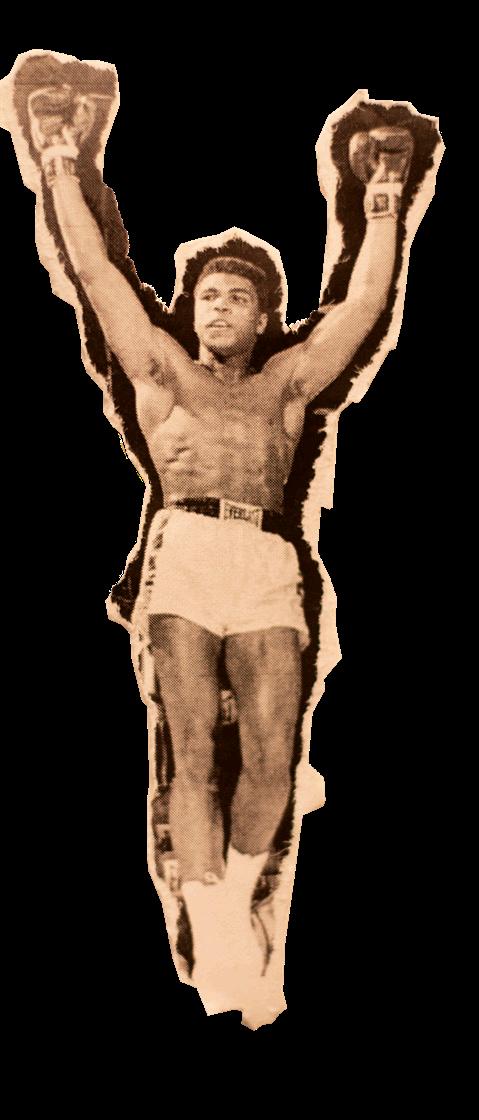
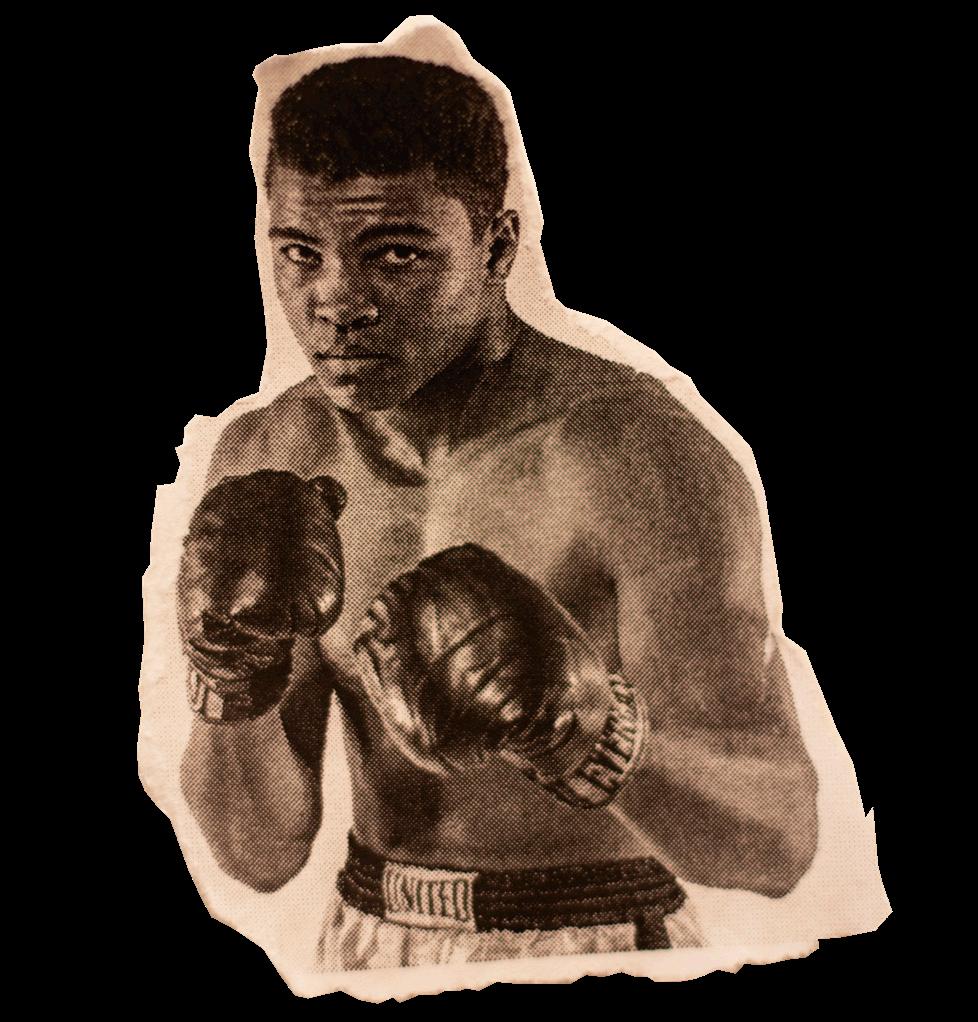
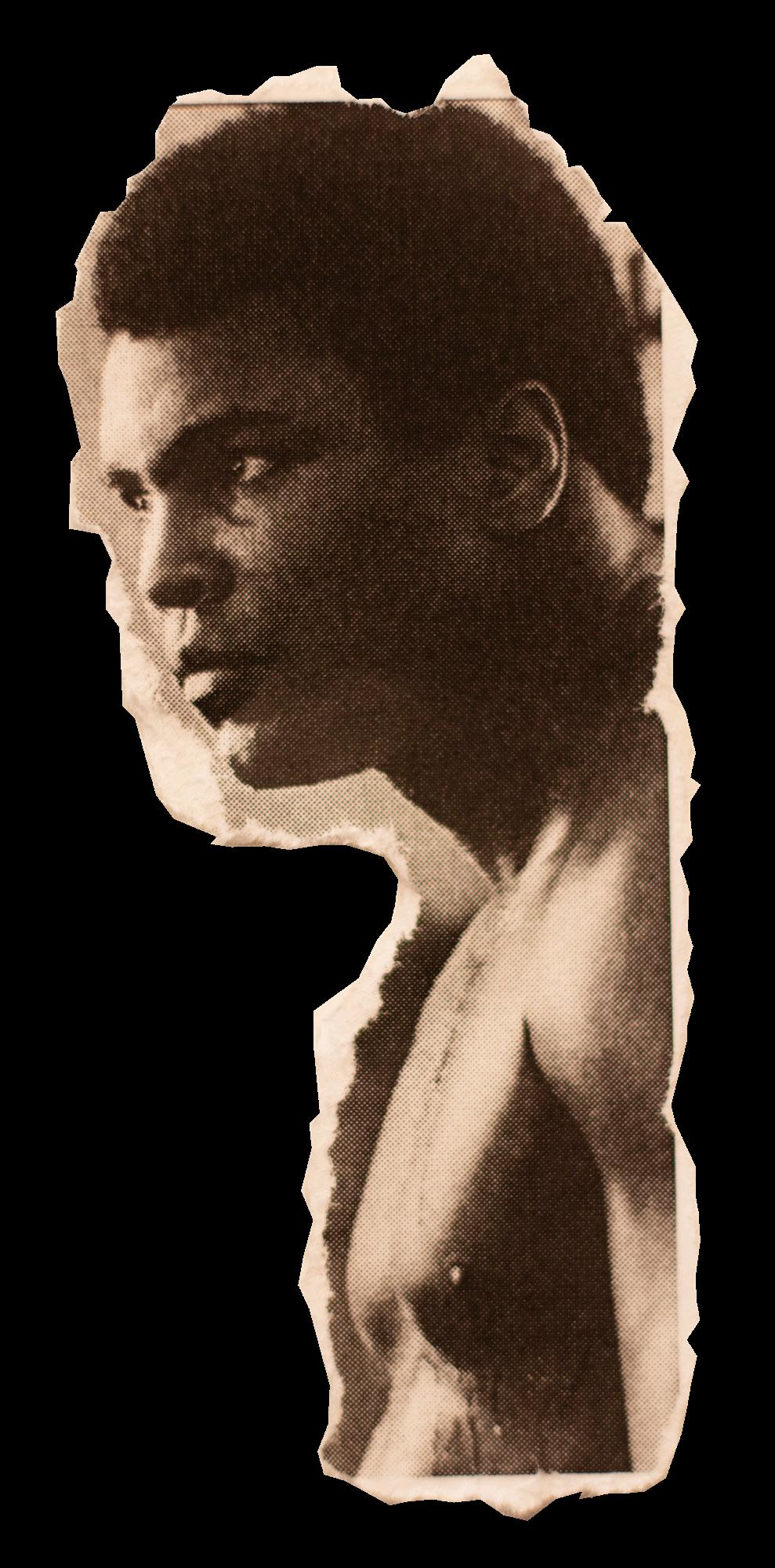

some “benefts and material comfort” for people living under the tribulations of enslavement.
However, the post-slavery segregation era had a profound impact on Black people’s relationship with swimming. During the era of segregation, Black individuals were systematically denied access to public swimming pools. These facilities were often designated as “whites only,” leaving Black communities with limited or no access to safe swimming environments.
In the long run, this deprived an entire generation of Black people of the opportunity to learn how to swim and also laid the groundwork for several racist stereotypes regarding the inability of Black people to swim.
The efects of these discriminatory practices have been long-lasting, directly contributing to lower rates of swimming profciency among Black people worldwide. Moreover, a recent study from the Ann & Robert H. Lurie Children’s Hospital of Chicago has shown that these cumulative factors have led to an intergenerational apprehension of water and the continued underrepresentation of Black people in swimming pools. According to the American Centre for Disease Control, if a child’s parents don’t know how to swim, there is only a 19 per cent chance that the child will learn. This is how the cycle persists.


The factors previously discussed have contributed vastly to the disproportionately low number of Black people in swimming. Yet, North America is far removed from slavery and deeply ingrained racial segregation, so why is the number of Black people participating in swimming still so low? The reason for this lies in current and systemic social and cultural barriers. Recreational swimming remains afordable in Canada and easily accessible compared to other sports. Nevertheless, becoming a competitive swimmer is expensive, leaving it largely inaccessible to Black Canadians, who, because of a history of socioeconomic discrimination, are heavily represented among the population that lives with

low income. According to Statistics Canada’s 2021 Census, 12.4 per cent of Black Canadians were living in poor households, compared to just 8.1 per cent of the total population in 2020.
Making it more fnancially accessible to swim competitively is a great way to ensure that Black Canadians and other individuals of lower socioeconomic backgrounds have equal access and opportunity to pools and lessons.
Furthermore, the lack of Black role models in swimming and negative stereotypes associated with Black people swimming are also contributing factors. Due to historically low numbers of Black people in swimming pools — competitive or recreational — a false perception persists among parts of the public that swimming is not a sport or skill for Black people. This perception, coupled with ridicule or discrimination faced by Black swimmers, can deter other Black people from participating.
Despite the glaring underrepresentation of Black people in competitive swimming and swimming as a whole, in recent times, some trailblazers have broken down barriers and made swimming a more attainable goal for young Black boys and girls.
Simone Manuel, Lia Neal, and Natalie Hinds are all athletes who have not only achieved personal success but have also served as global role models for future generations of Black swimmers. They have shown that swimming is a sport where everyone can participate and excel, regardless of race or background. Furthermore, here in Canada, swimmers such as Jacky Beckford have devised initiatives to help teach Black and other racialized individuals how to swim for free in hopes of combatting historic inequities.
However, there is still more work to be done to fx the economic barriers that are preventing Black people from getting into swimming. Furthermore, it will take time for the Black community globally to heal from the years of trauma inficted through slavery and segregation.
As more Black swimmers rise to prominence and more resources are dedicated to making swimming accessible for all, hopefully in the future the pool can become a place of inclusivity and diversity.
My fondest memories from my childhood involve my whole family sitting in the living room enjoying music together. The voices of Bob Marley, Jimmy Clif, Lauryn Hill, Boney M., and so many other artists would fll the room, and I would have a profound sense of peace as I felt the music. Music continues to fll my world and brings me my greatest comforts, and I want to
thevarsity.ca/category/illustrations illustration@thevarsity.ca
appreciate the Black artists who pioneered the music many enjoy today.
Poly Styrene is a name that many people may not know, but to Black women in alternative spaces such as myself, she is an icon. A biracial woman in the ’70s punk scene, many saw her as an outcast and “poseur.” As the frontwoman of the band X-Ray Spex, she sang about her experiences in the scene and became an inspiration to many.
On the opposite end of the spectrum, Tupac Shakur is a household name. His powerful
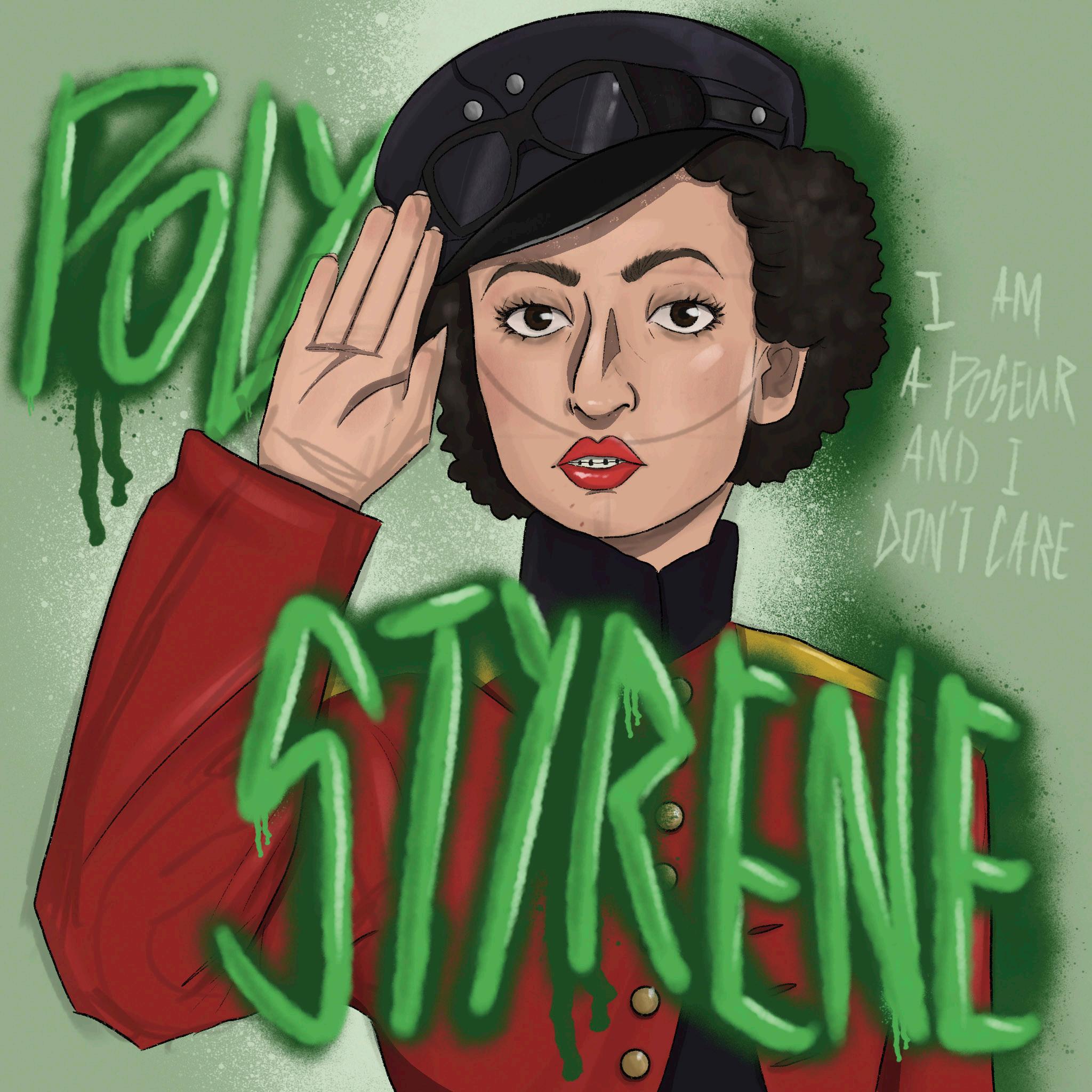

lyrics inspired everybody, no matter what the circumstances are, to keep going and look forward to a brighter tomorrow. Taken from us too soon, his music still reminds all to keep their heads up. Queen Latifah is a reminder that queerness and blackness can exist together. She sings of “U.N.I.T.Y” and uplifting each other. The combination of her lyricism and her mere presence as not just a rapper is an inspiration to be yourself.
Finally, Tyler the Creator is a recent and extremely popular example of a Black artist breaking the

mould, and revolutionizing the music scene. Tyler’s unique sound and style have garnered him immense popularity and a cult following. I believe that without the three artists mentioned before, we wouldn’t have Tyler.
All of these artists gave us what we have today and speak to many listeners on a unique level. Combined, they made me realize I have a place in this world, and I’m just as good as anyone else.
Illustrated by Isio Emakpor
